Our feelings were mixed as we checked out of the Royal Plaza Hotel Tiberias and loaded up the bus this morning: it was exciting to think about another full day of educational and edifying sightseeing, but lurking in the back of our minds was the awful realization that the next place most of us would have a chance to unpack and lie down would be back in our own homes. But we’ll have plenty of time to think about that once we get to the airport tonight; right now, we’re heading to Nazareth.
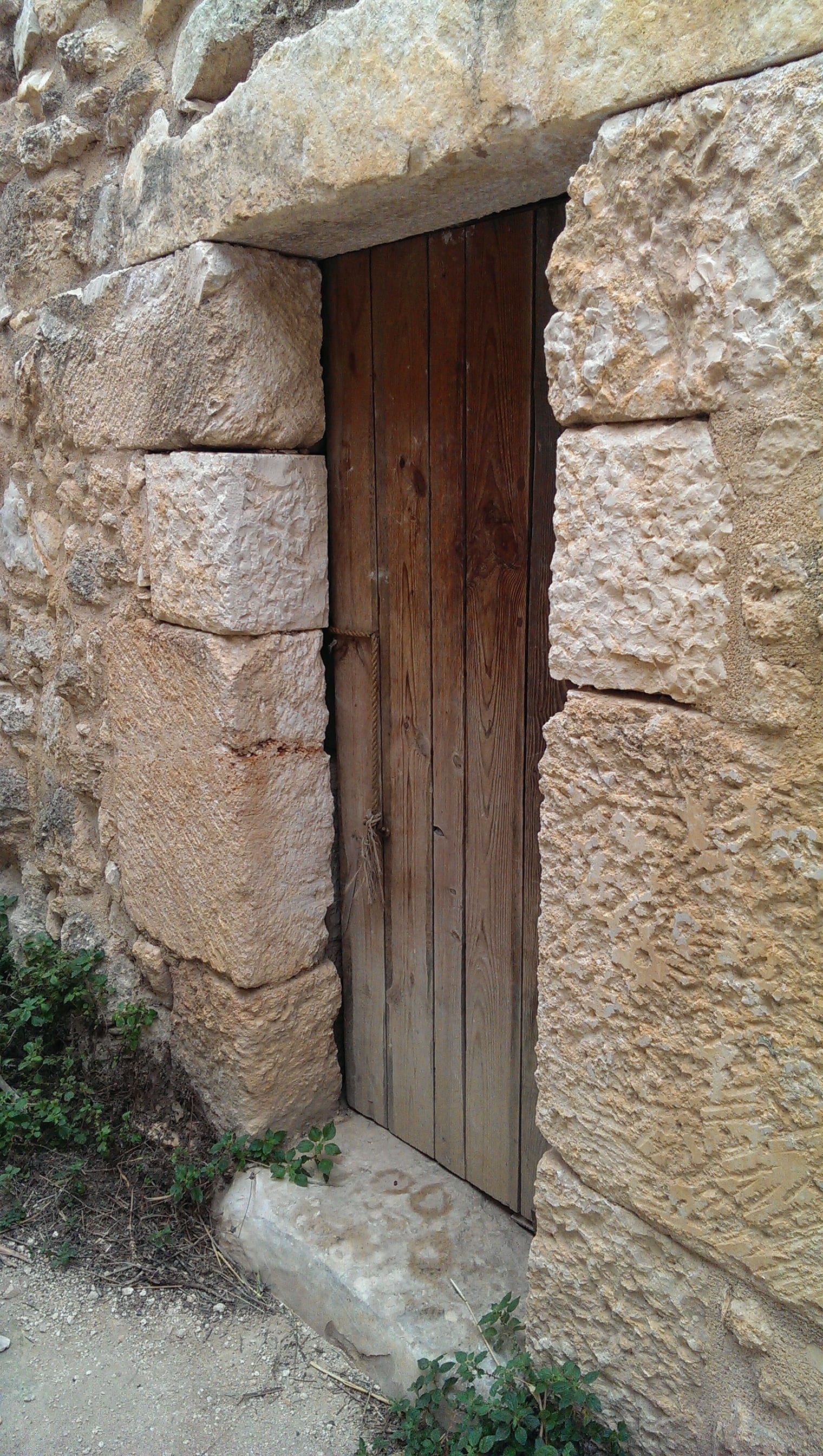
A household in Nazareth: “Behold, I stand at the door and knock.”
Rather than have us hit up a lot of churches marking the “exact spots” where Joseph had his carpenter’s shop and Mary received the Angel Gabriel’s stunning announcement, our guides decided that we should spend the morning at Nazareth Village, a reconstruction of what the town would have been like during Jesus’s childhood. (Think of it as sort of an Israeli version of Williamsburg or Nauvoo.) The village doesn’t claim to be built on the site of any specific event recorded in the Bible, but it does include several significant archaeological finds dating from the first century AD.
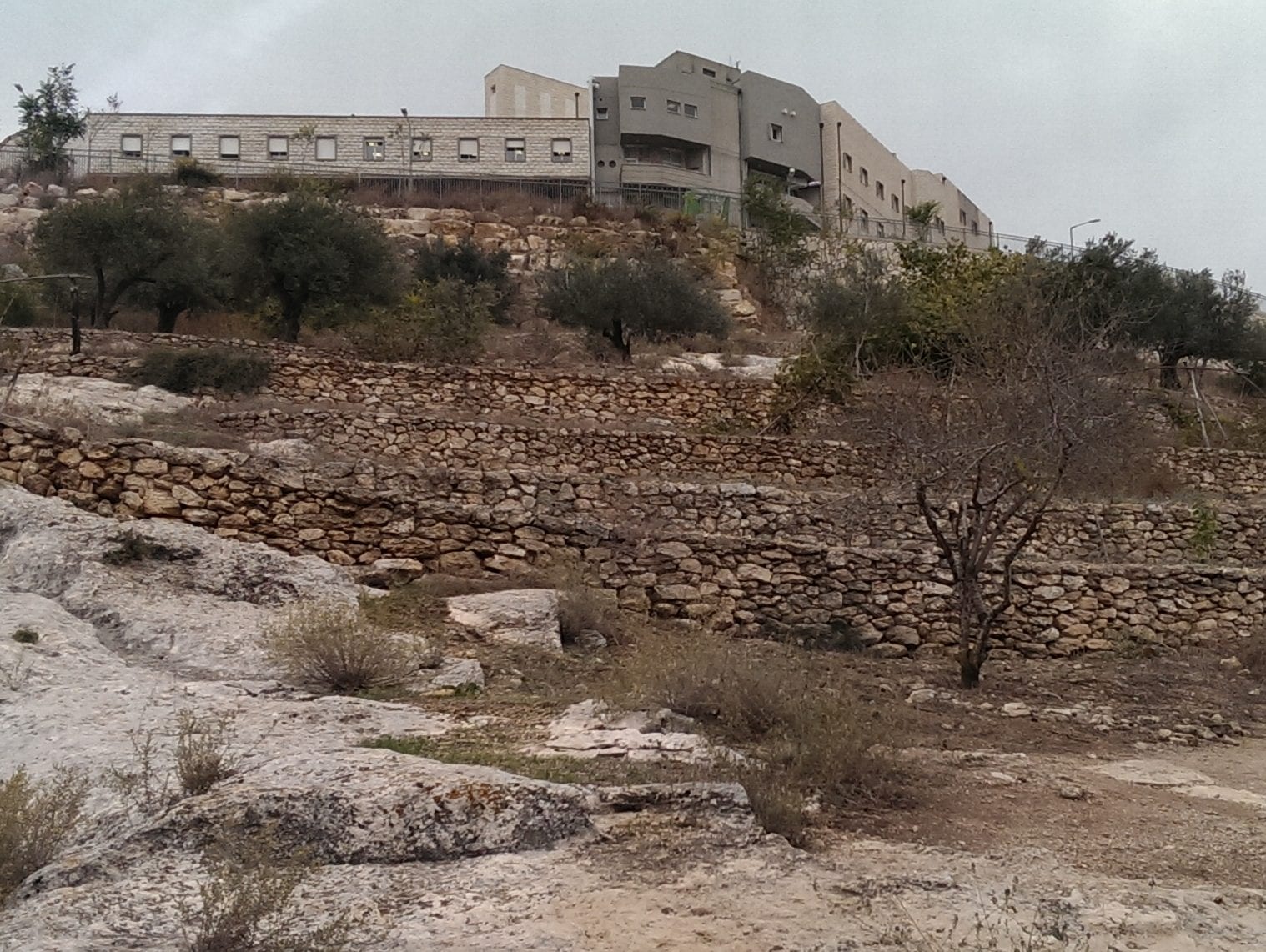
The terraced hillside behind Nazareth Hospital
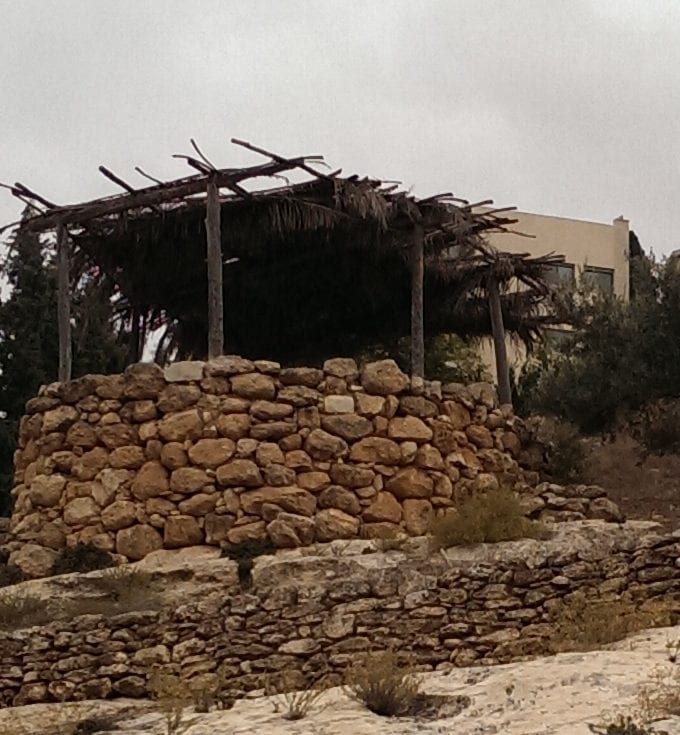
Reconstructed watchtower
Nazareth Village is located on a fifteen-acre slope behind the Nazareth Hospital, formerly the English Hospital, which was established in 1906 by the Edinburgh Medical Missionary Society. This property was owned by the hospital but had remained undeveloped until the 1990s, when the administration decided to authorize archaeological exploration. Digging revealed agricultural terraces indicating that the property had once been farmed; further excavation unearthed the foundations of a couple of watchtowers, a spring-fed irrigation system, and a stone quarry. The discovery of a winepress hewn out of the bedrock led to the conclusion that the site must have been a vineyard.
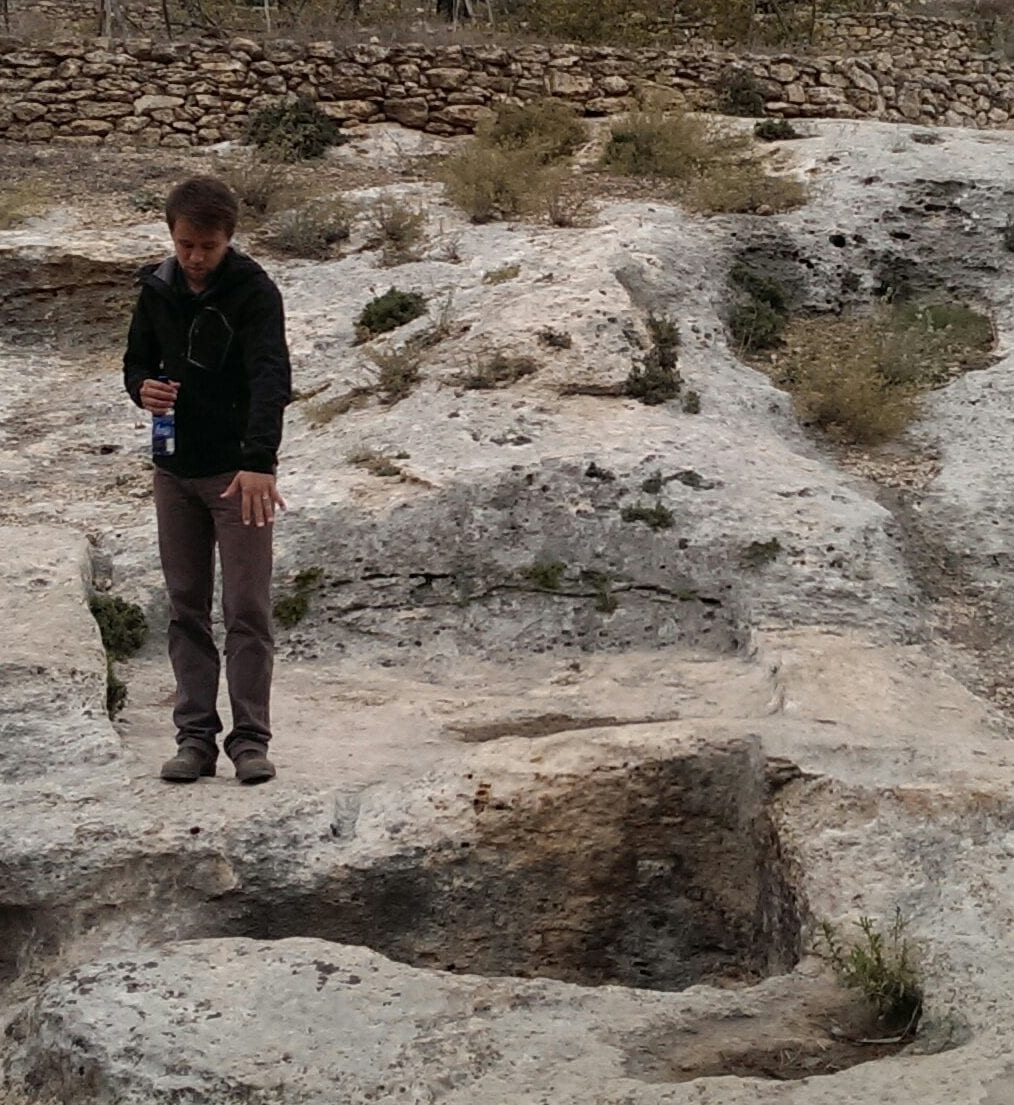
Yoshi points out features of the winepress
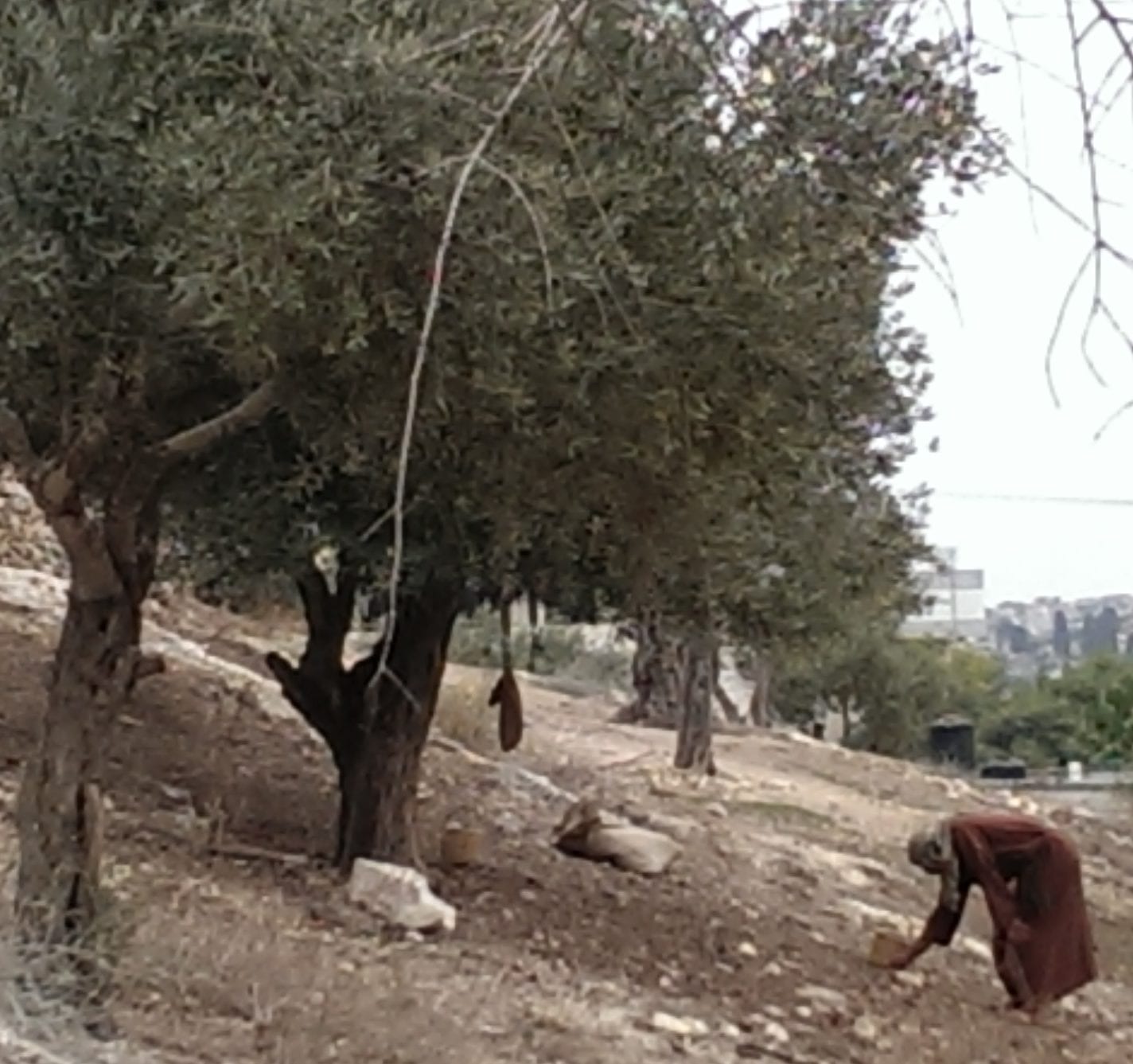
Costumed workers tend the olive trees
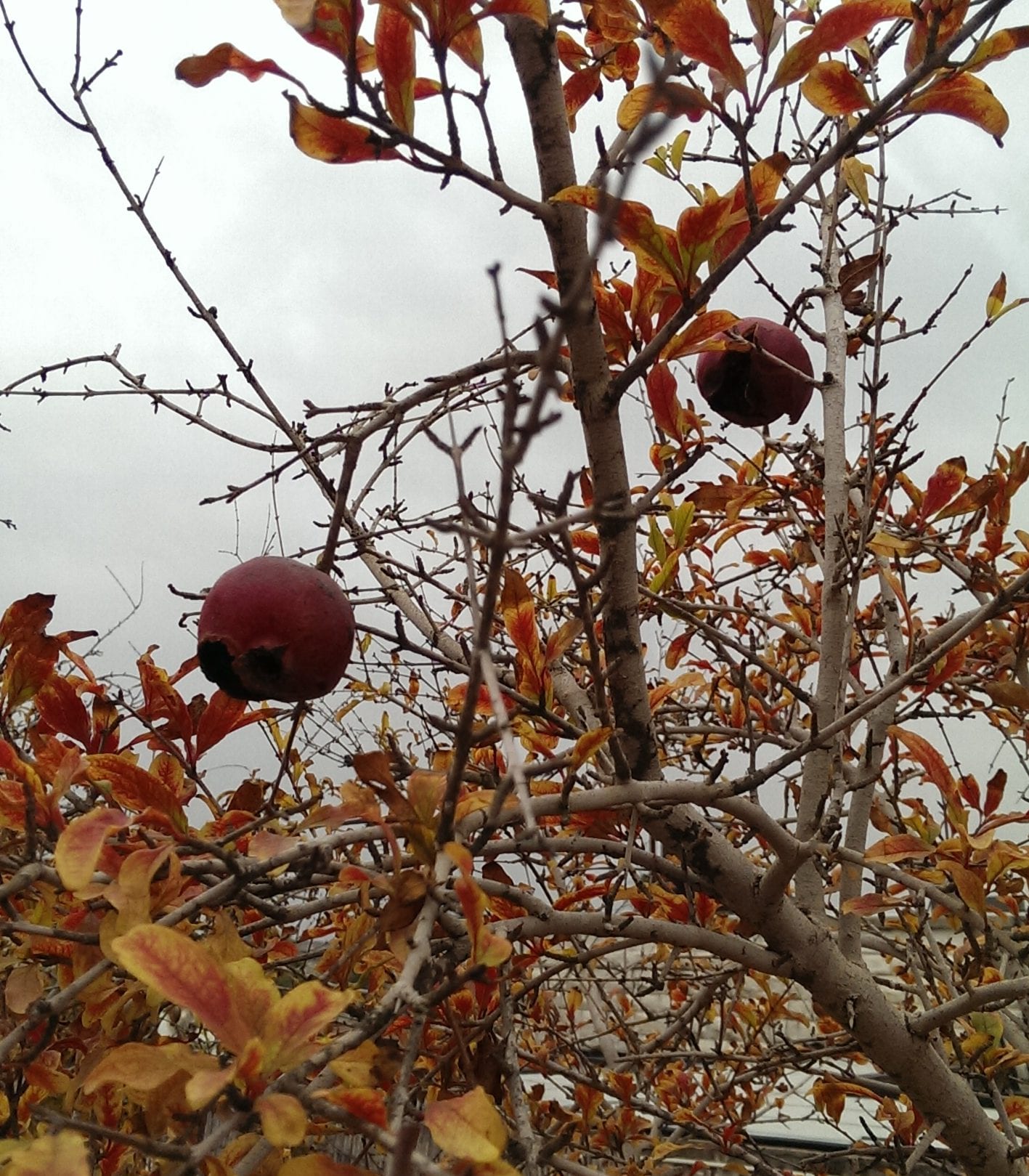
A few late pomegranates linger on a withering tree
After studying excavated structures from the same period and researching ancient texts, historians working for the Nazareth Trust reconstructed an agricultural village using authentic materials and Roman-era building techniques. The farming terraces were restored to their original condition and planted with olive trees, pomegranates, and grapes, which now are tended in first-century fashion by reenactors dressed in period costume.
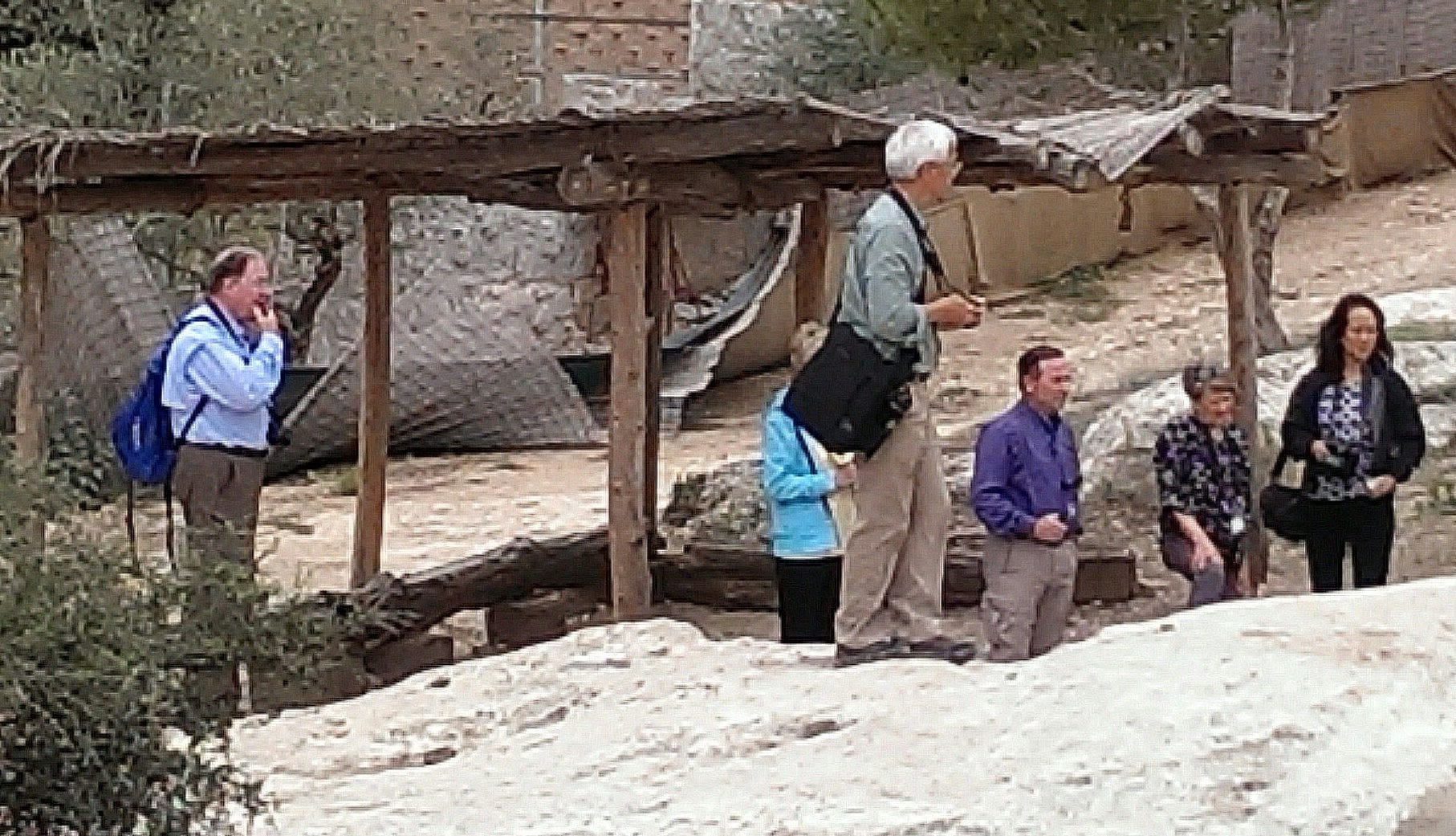
The sheepfold
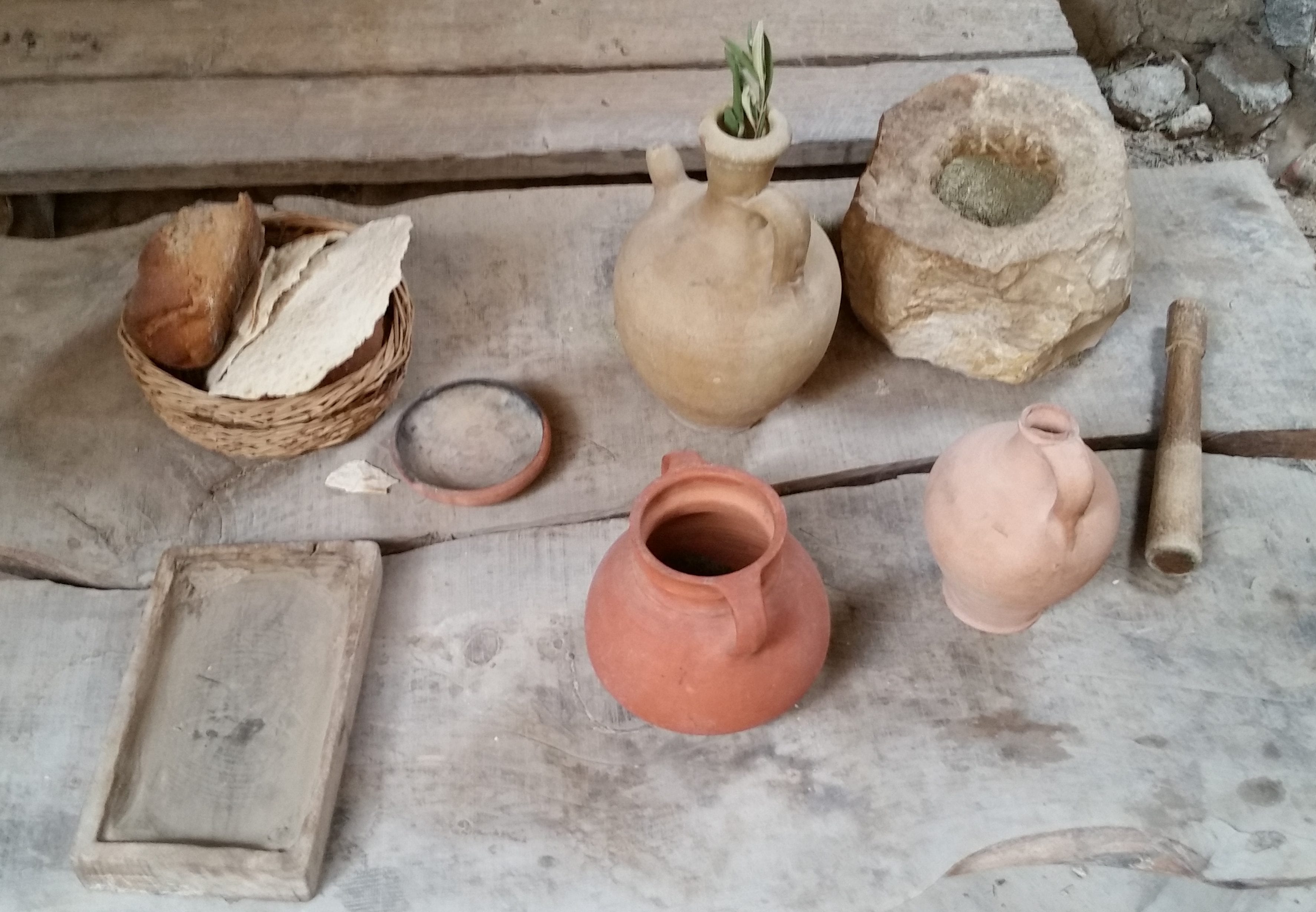
Household utensils
Nazareth Village, which was opened to the public in 2000, also includes a sheepfold, a few craft shops, and a couple of dwellings where re-enactors show visitors how villagers went about their daily lives two thousand years ago. A small museum displays artifacts found on the property and the learning center provides additional background information.
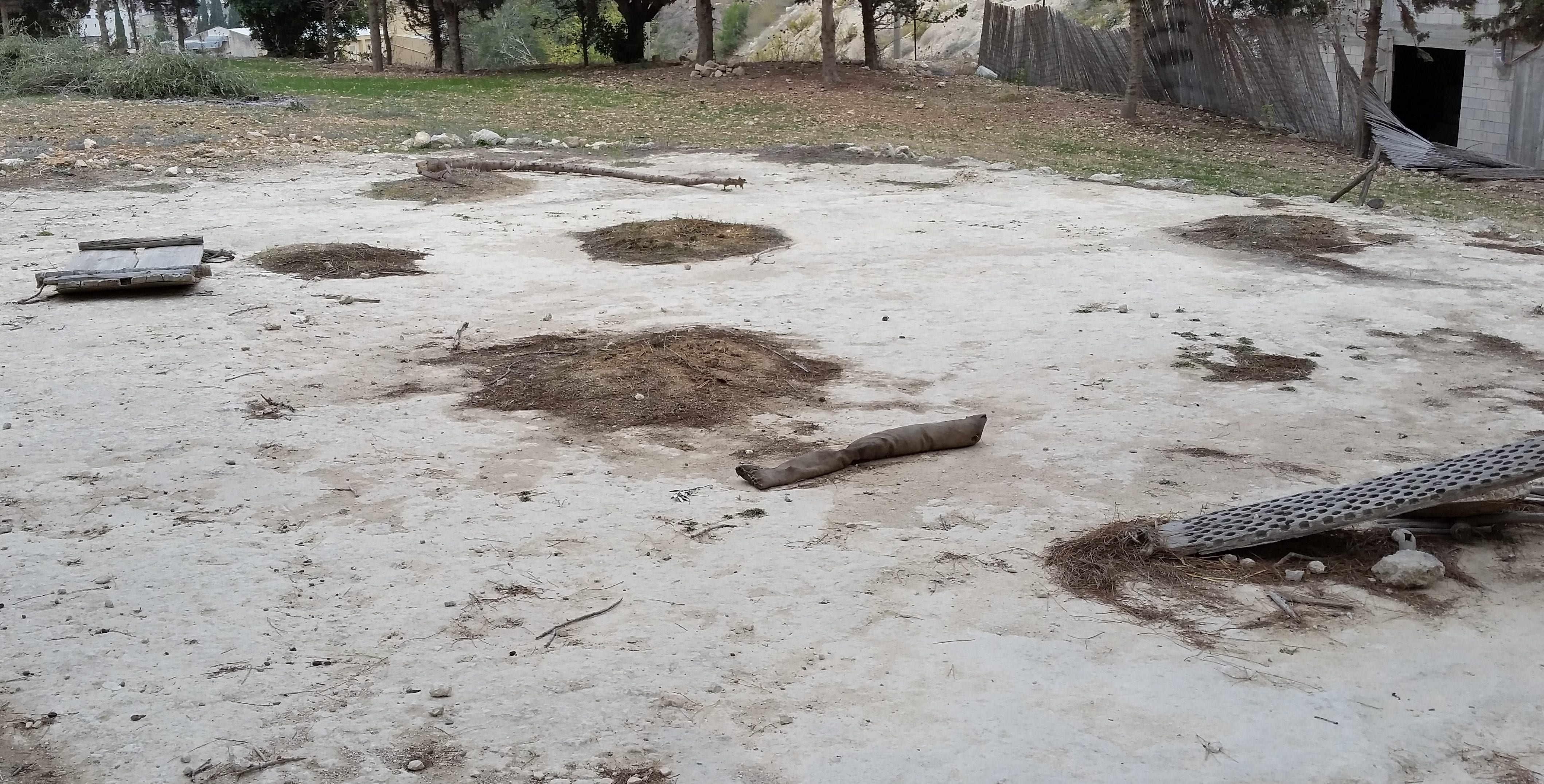
Threshing floor
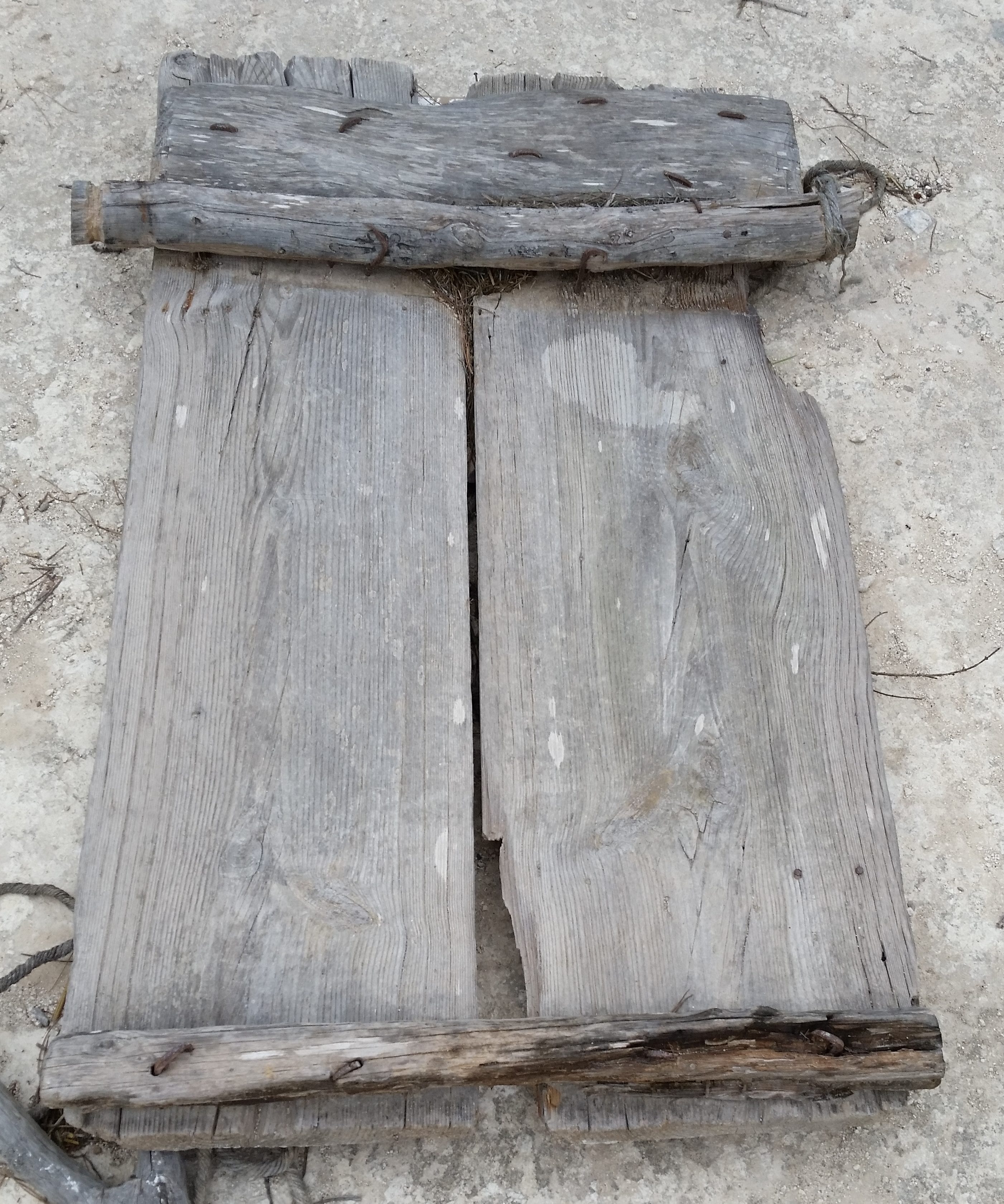
Palette, pulled by an animal used to separate wheat from chaff
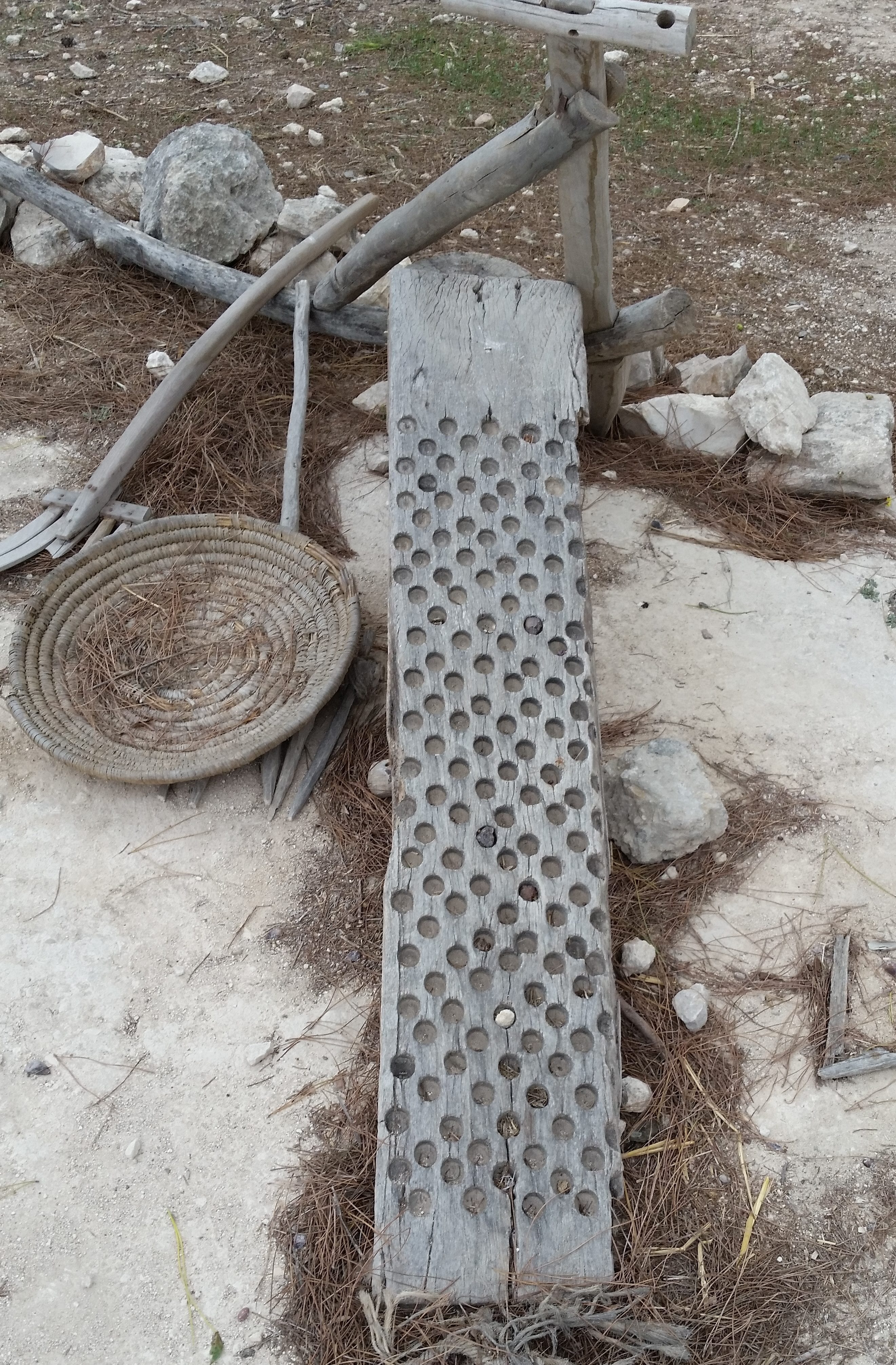
The underside of the palette
Our guide through the village was a young man named Yoshi. A Messianic Jew, he had been born in Russia and then spent three years in the U.S. before migrating to Israel.
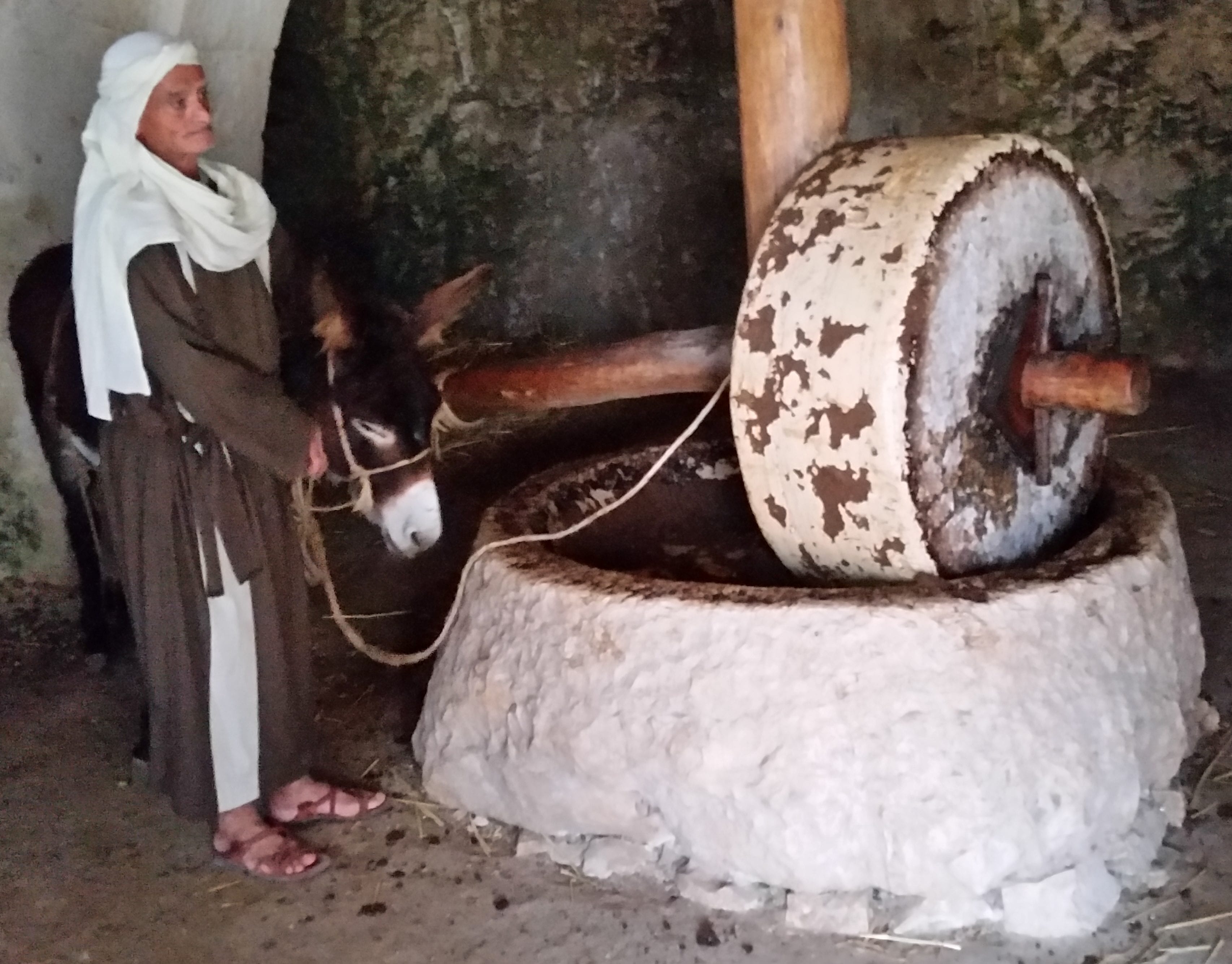
Worker and donkey mashing the olives
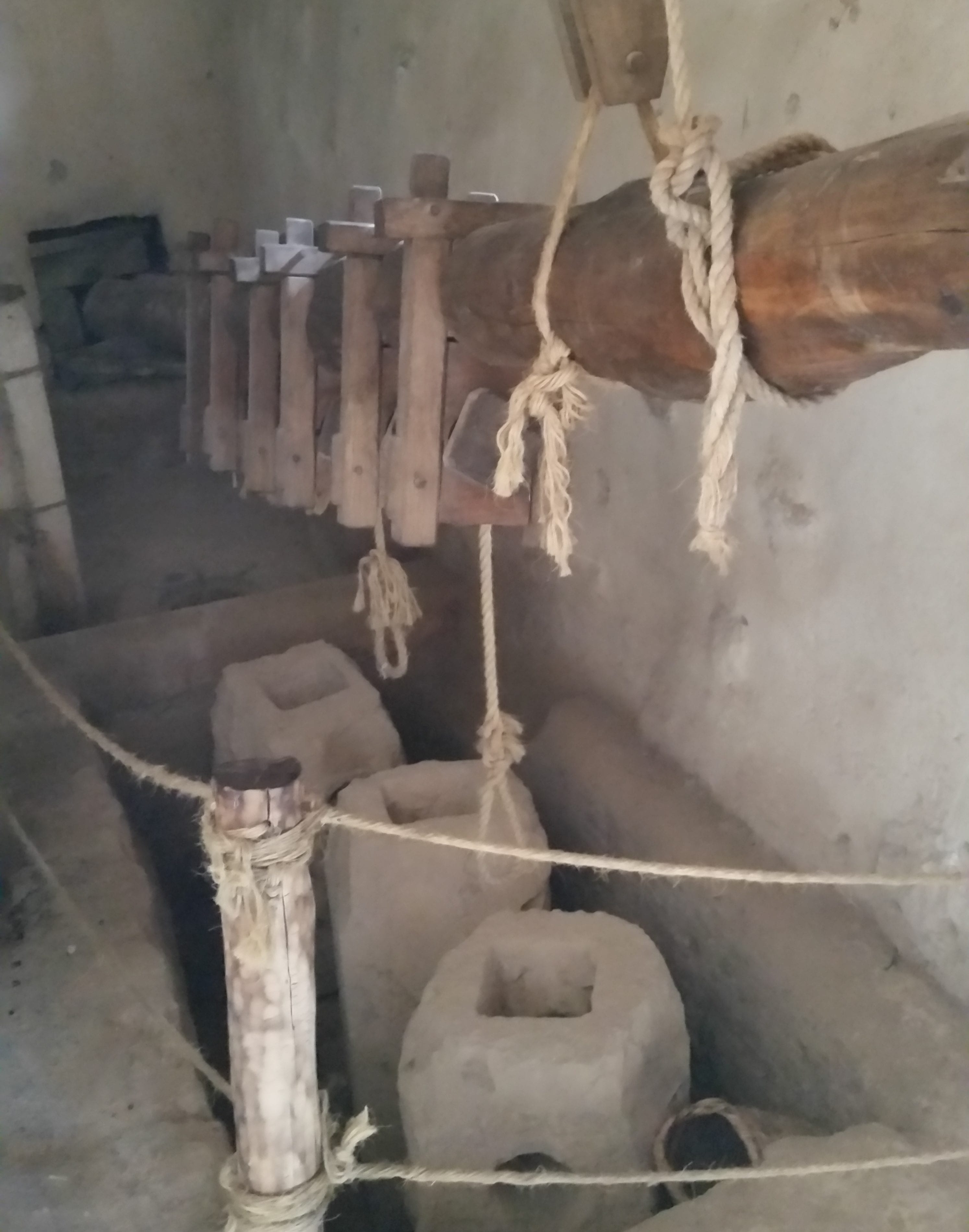
Olive press
In a barn, we watched a worker lead a donkey around and around as he mashed the olives, the first step in extracting the oil. Yoshi then demonstrated how to use the nearby olive press, explaining that oil from the first pressing (what we would call “extra virgin”) was dedicated for use in the temple; oil from the second pressing was used for food and medicine, and the third pressing went into lamps or was made into soap. The watery liquid from which the oil was skimmed was mixed with clay for plastering homes and storerooms because it is a natural insect repellent. Solid sediment left from the olives was dried and burned; nothing went to waste.
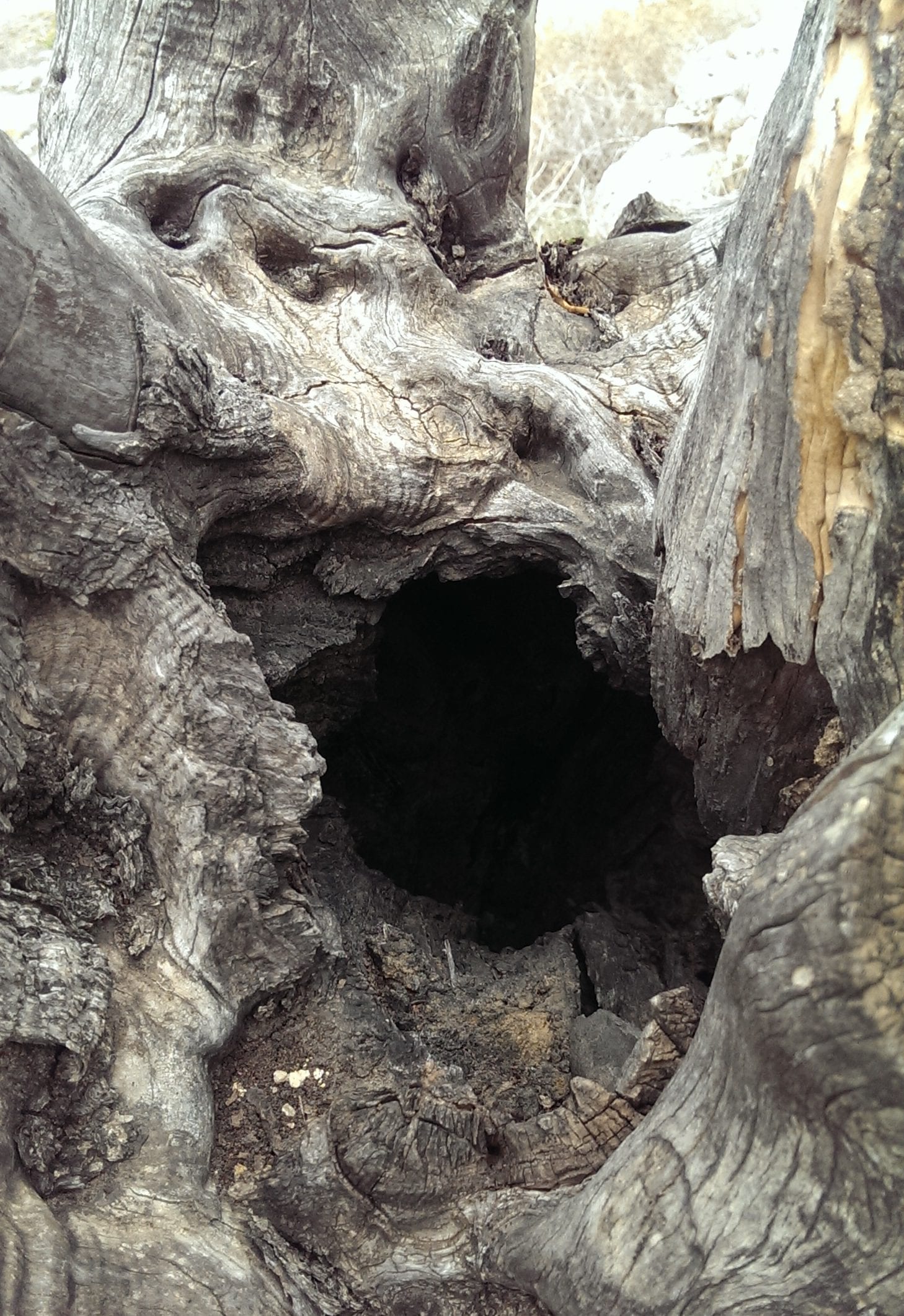
Looking down into an olive tree’s hollow trunk; the hole is about 12 inches in diameter
Yoshi also told us that although olive trees live for a very long time, they tend to hollow out as they grow, so their age cannot always be determined by the number of growth rings. The husbandmen who tend the trees fill their hollow trunks with stones to provide additional support. Olivewood is extremely dense and durable, but because the trunks and branches are often very twisted, much of the wood is more suitable for furniture and small objects such as bowls and decorative carvings than for large construction projects.
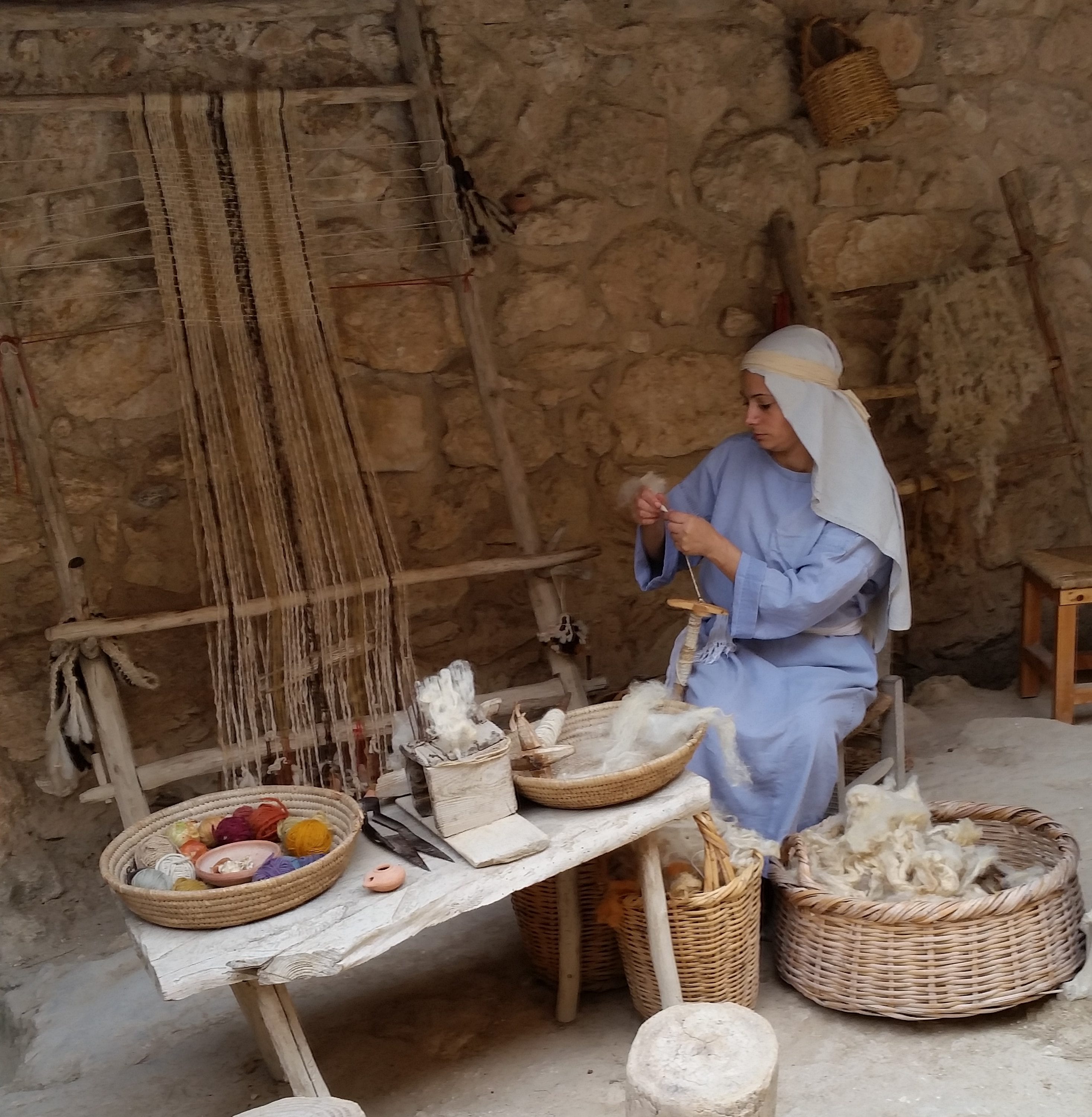
Weaver
The weaver gave us a spinning demonstration, and showed us samples of the local plants and minerals that were used to produce dyes to color the wool. (Purple and blue could be obtained only from the ink of sea snails from the Mediterranean. It was very costly, which is why those hues were usually reserved for royalty.) She also taught us the difference between men’s and women’s apparel in the days when everyone wore robes: Hebrew women typically wore clothing made of solid-colored fabrics, while the men wore striped patterns that indicated their tribe. Another distinguishing feature was their headgear: Men wore a small cap or a simple one-piece shawl when they needed to cover their heads; women tied an extra scarf around their headshawl to hold it in place.
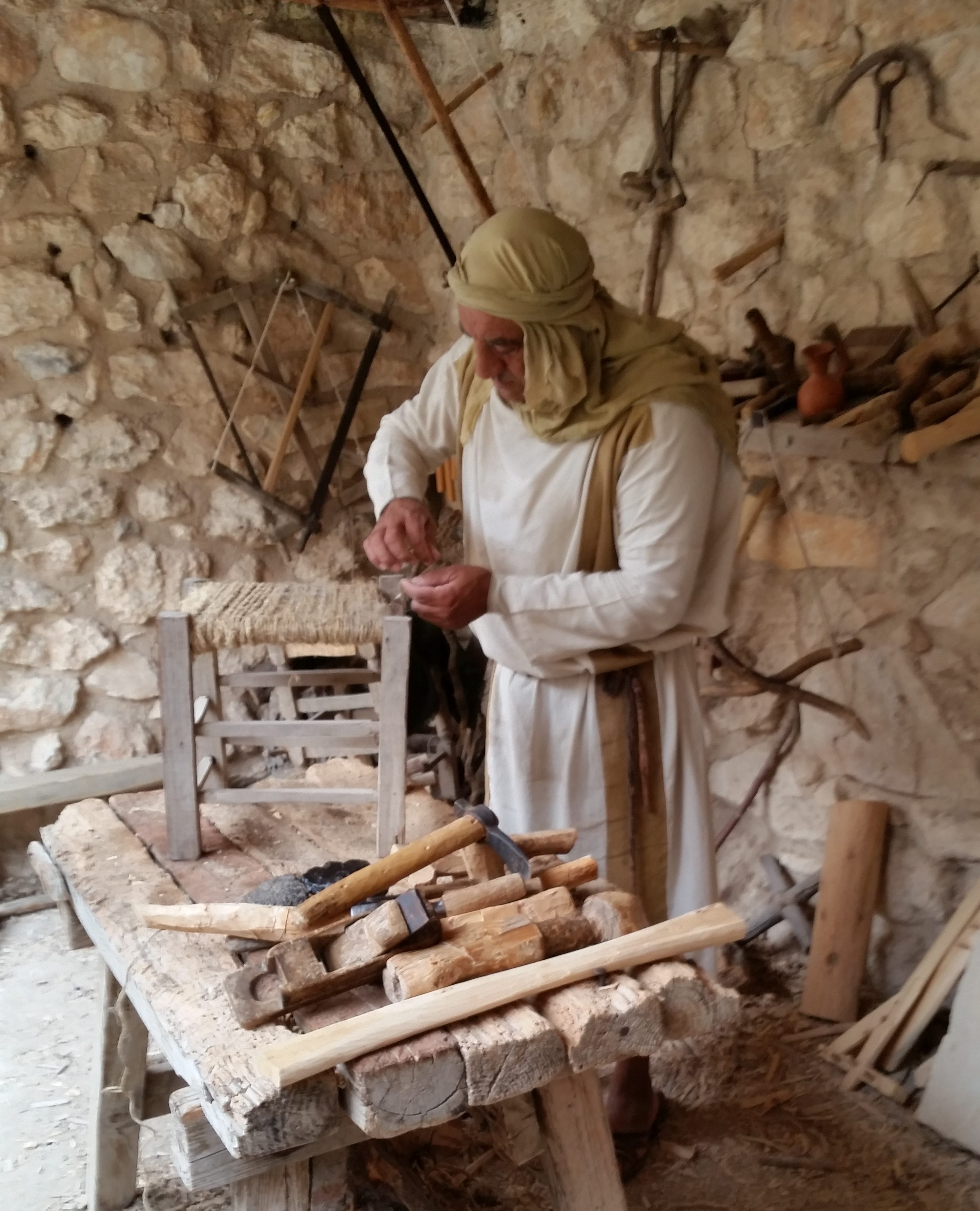
Carpenter
One of the shops in the village reconstruction is a carpenter’s shop, where a few members of our group got to try out a first-century drill. We were intrigued to learn, however, that the Greek word tekton, used in the Bible to describe the occupation of both Joseph and Jesus and usually translated into English as carpenter, does not necessarily refer to a woodworker. Rather, the term means something more general, such as “builder” or “craftsman,”and thus may apply to a variety of trades, including stonemasonry and metalworking. Displays in the learning center at Nazareth Village suggest (and Jim Gee concurs) that because wood is scarce in the land of Israel, it’s more likely that Joseph and his sons–including Jesus–worked in stone, probably helping to construct some of the edifices whose ruins we visited in Capernaum, as well as some we were about to see in Zippori National Park.
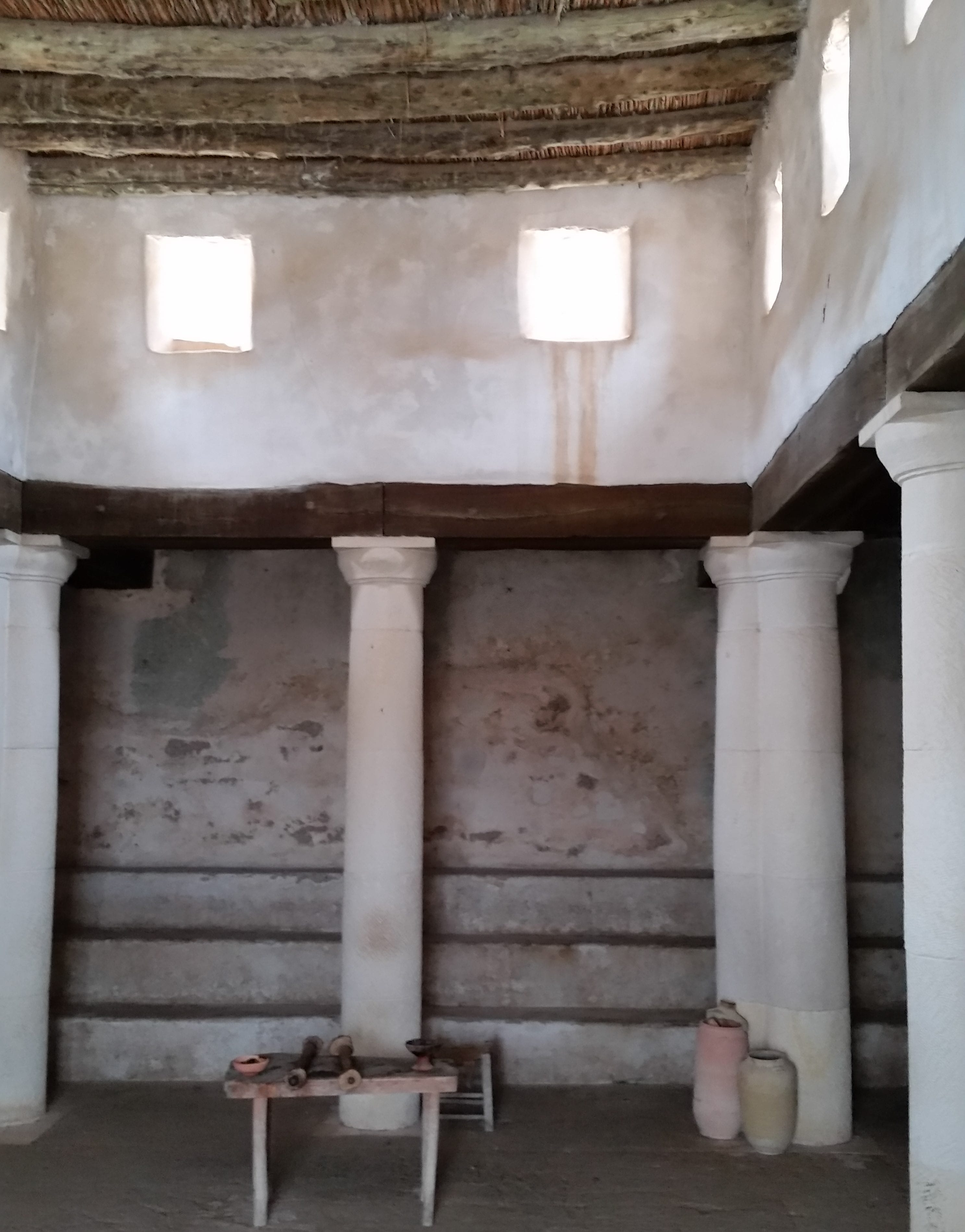
Inside the synagogue
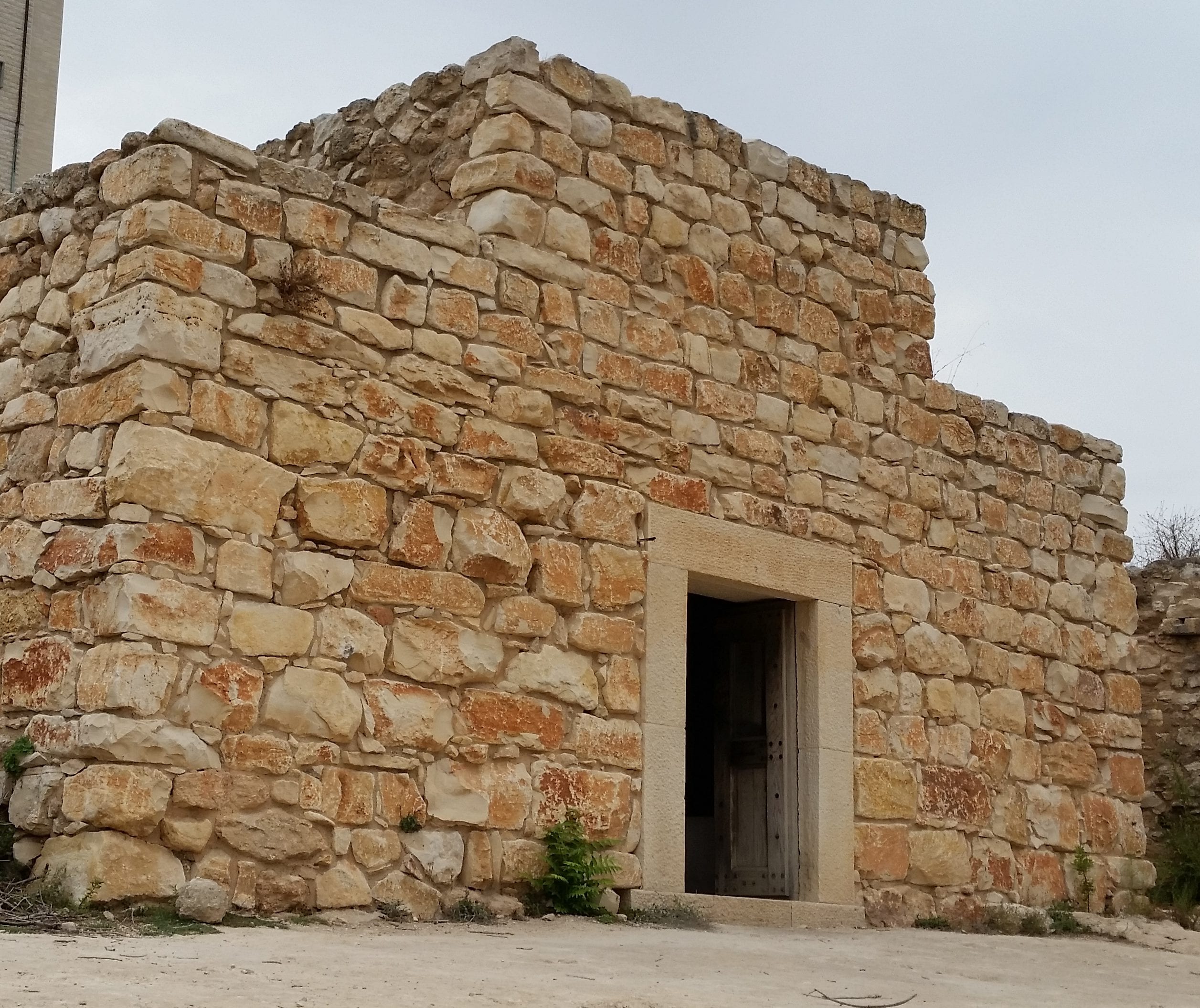
Synagogue
Zippori (known as Sepphoris in Greek) is four miles from Nazareth, and was the capital of Galilee during Christ’s lifetime. Like most important cities in this area of the world, Zippori has a long history of human habitation and conquest, destruction and reconstruction.
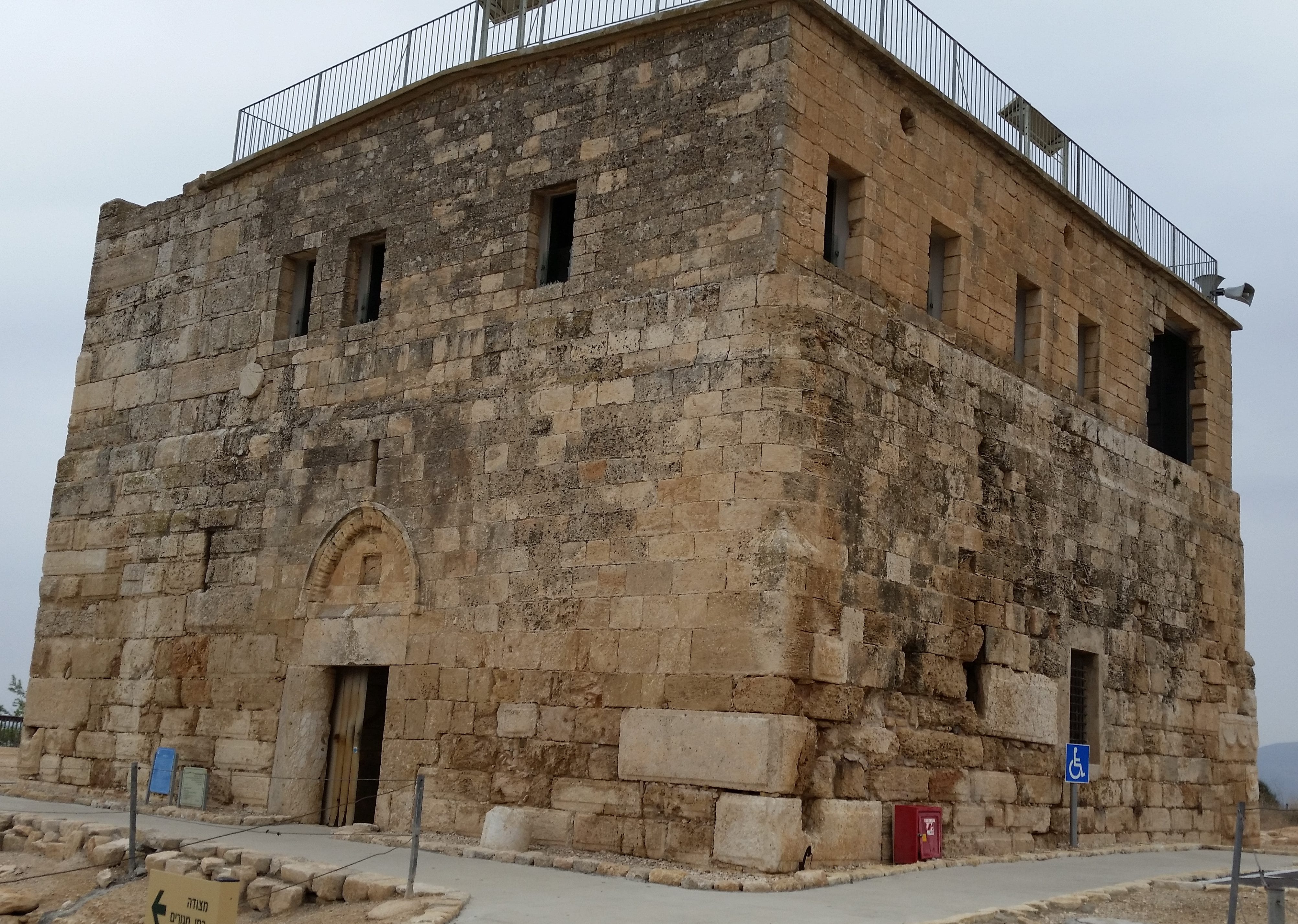
Fortress of the Knights in Zippori
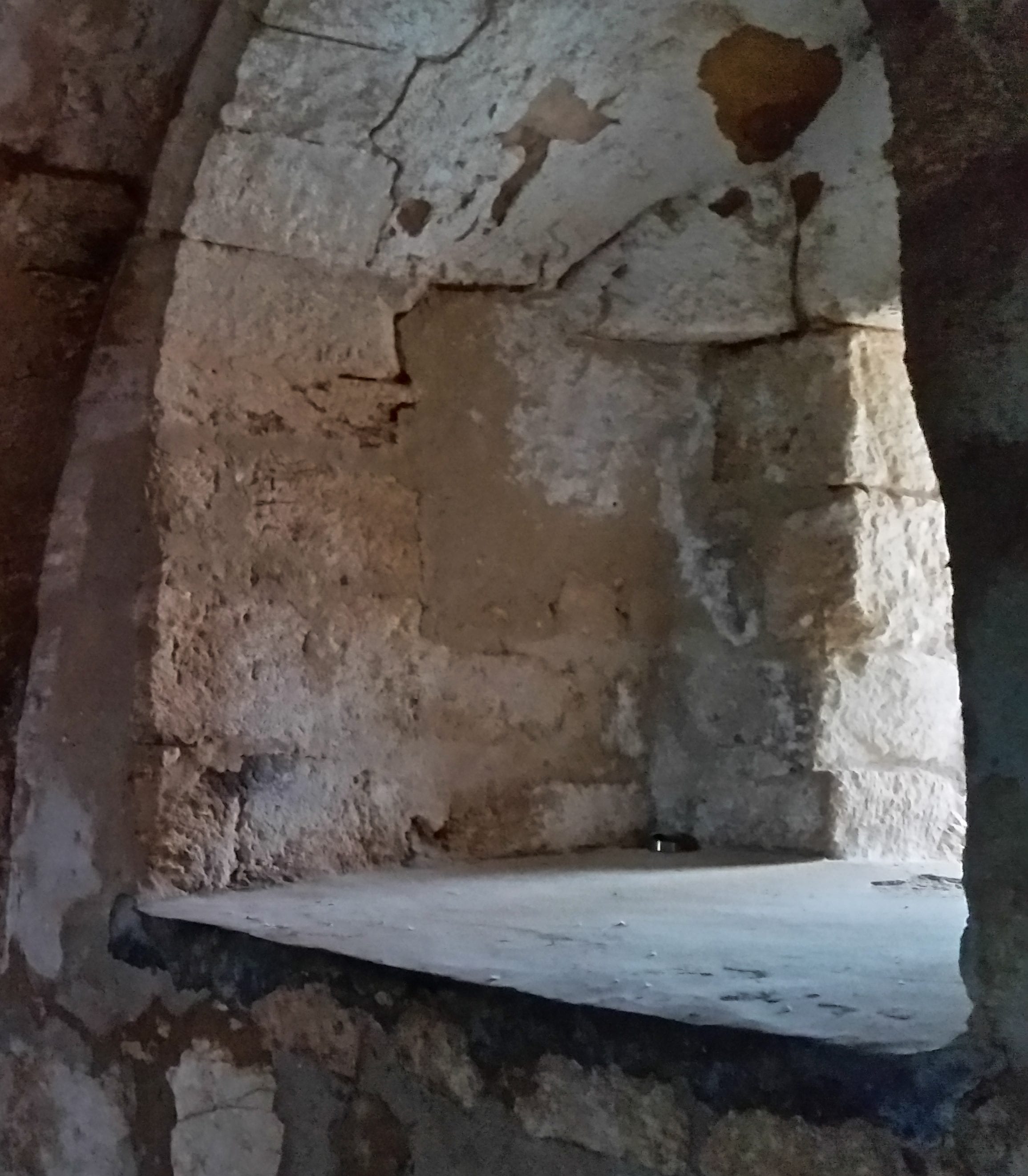
Extra thick walls inside the fortress
A Roman army put down a Jewish revolt here following the death of Herod the Great by burning the city, but Herod’s son Antipas soon rebuilt it in typically grand fashion. When the larger rebellion that led to the destruction of Jerusalem broke out a generation later, the Jews of Zippori surrendered to Vespasian without a fight, thus preserving the beautiful city that Jesus and his brothers probably helped to build. It is interesting that although Jesus undoubtedly spent time in Zippori during his youth, the town is never mentioned in the New Testament, possibly because most of its inhabitants were either Roman citizens or Roman sympathizers and thus not “good soil” for receiving the gospel of Christ.

Stands of prickly pear cactus form a natural defense around the fortress at Zippori
Zippori continued to thrive as a properous cosmopolitan city for centuries even though its governance shifted among various political entities. While again under Jewish rule in the third century, Zippori became the seat of the Sanhedrin, Judaism’s highest council of lawyers. Rabbi Judah Hanasi, leader of the Sanhedrin, lived here while compiling the Mishnah, the first written record of oral traditions based on the Talmud.
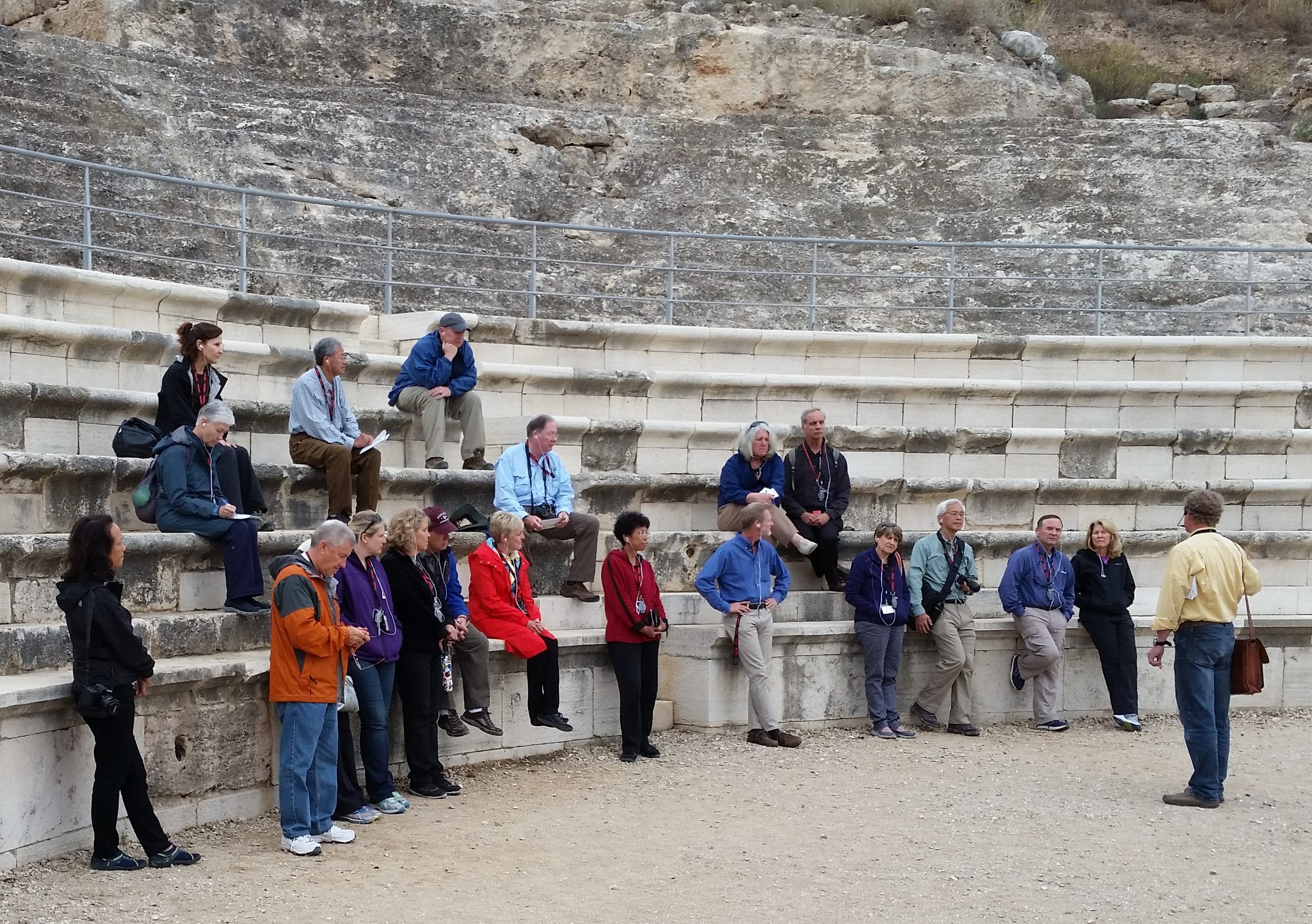
Roman theater in Zippori
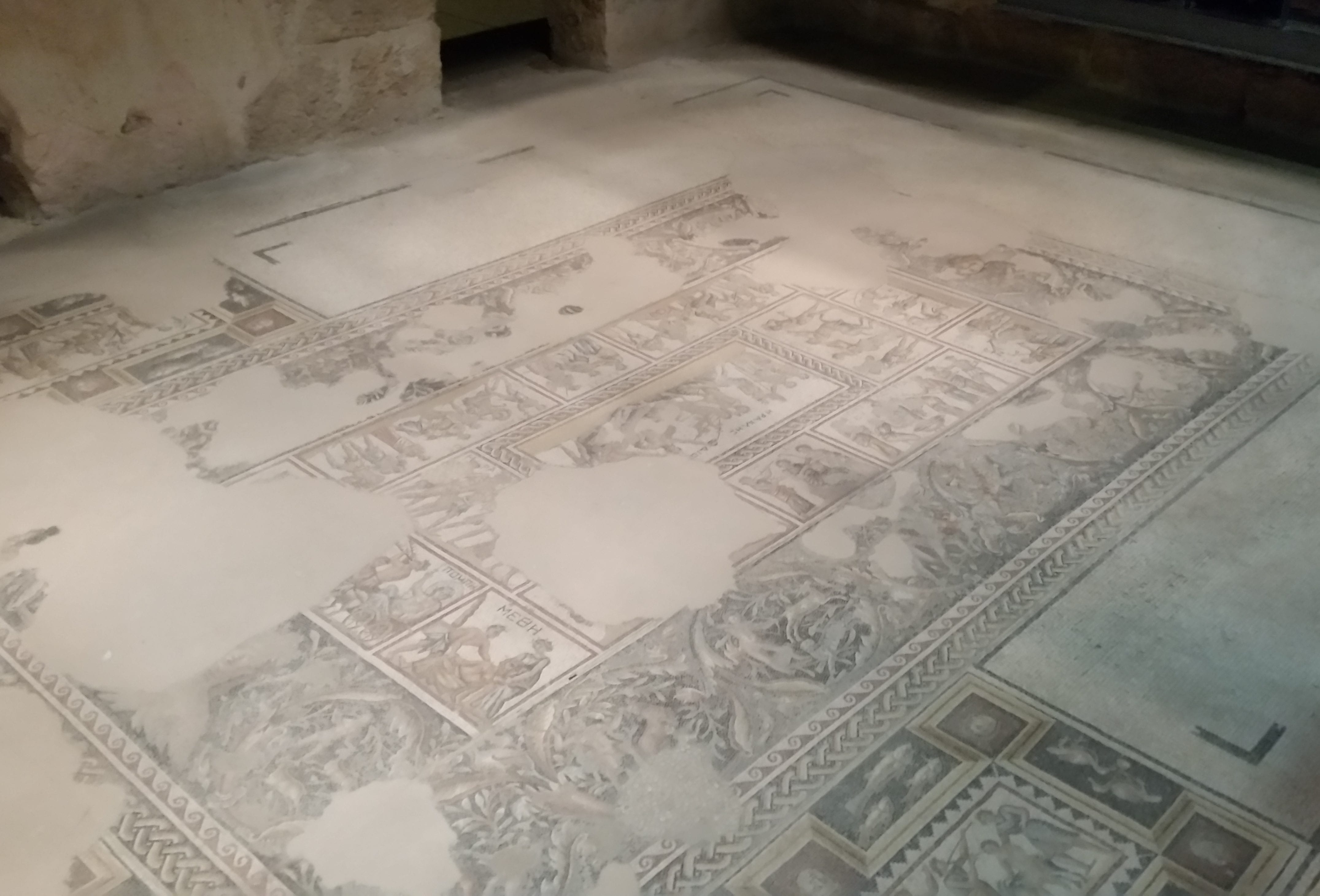
Zippori Bathhouse floor
Notable structures that we visited in Zippori National Park include a Roman theater, a bathhouse, a synagogue, and a mansion with a well-preserved triclinium dining hall containing mosaics depicting Dionysus and some attractive women.
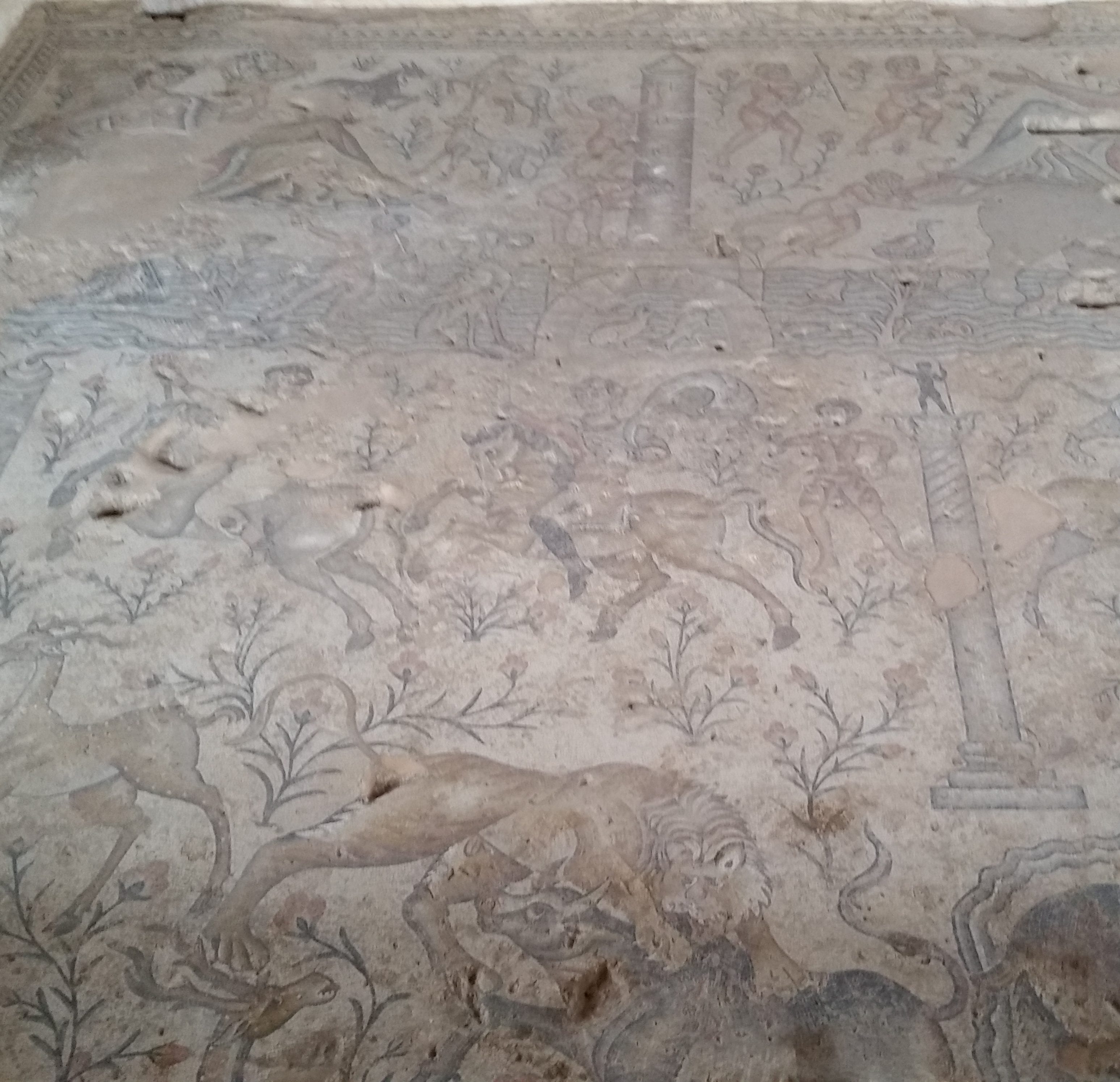
Mosaics in Zippori’s Nile House
Another huge mosaic showing Egyptian celebrations during the seasonal overflowing of the Nile is protected by a pavilion nearby. We also saw an early Christian church built on the traditional site of the home of Anna and Joachim, whom legend has identified as the parents of Mary, the mother of Christ, and visited the museum housed in a Crusader-era fort that was renovated in the eighteenth century.
From Zippori we traveled west toward the Mediterranean through the foothills of Mount Carmel. On top of this mountain, Elijah and the priests of Baal met to see whose god could send down fire to consume the sacrificial animals they had laid on their respective altars. While we didn’t get to see Jehovah smoke the competition, we did get to watch at close range while the cooks who prepared our lunch fried falafel balls and breaded chicken filets to crispy perfection. We’re glad their fires were sizzling hot, because after we finished eating, we watched the servers gather up unconsumed pita bread from our plates and return it to the fry cooks. Apparently, our discards would later reappear on the salad bar as fried pita chips. Mmm …
We had to hurry to get to Caesarea Maritima before closing time; it’s Friday, so preparations for the Jewish sabbath would shut everything down earlier than usual, and we wanted to see as much of this Roman-era coastal resort as we possibly could.
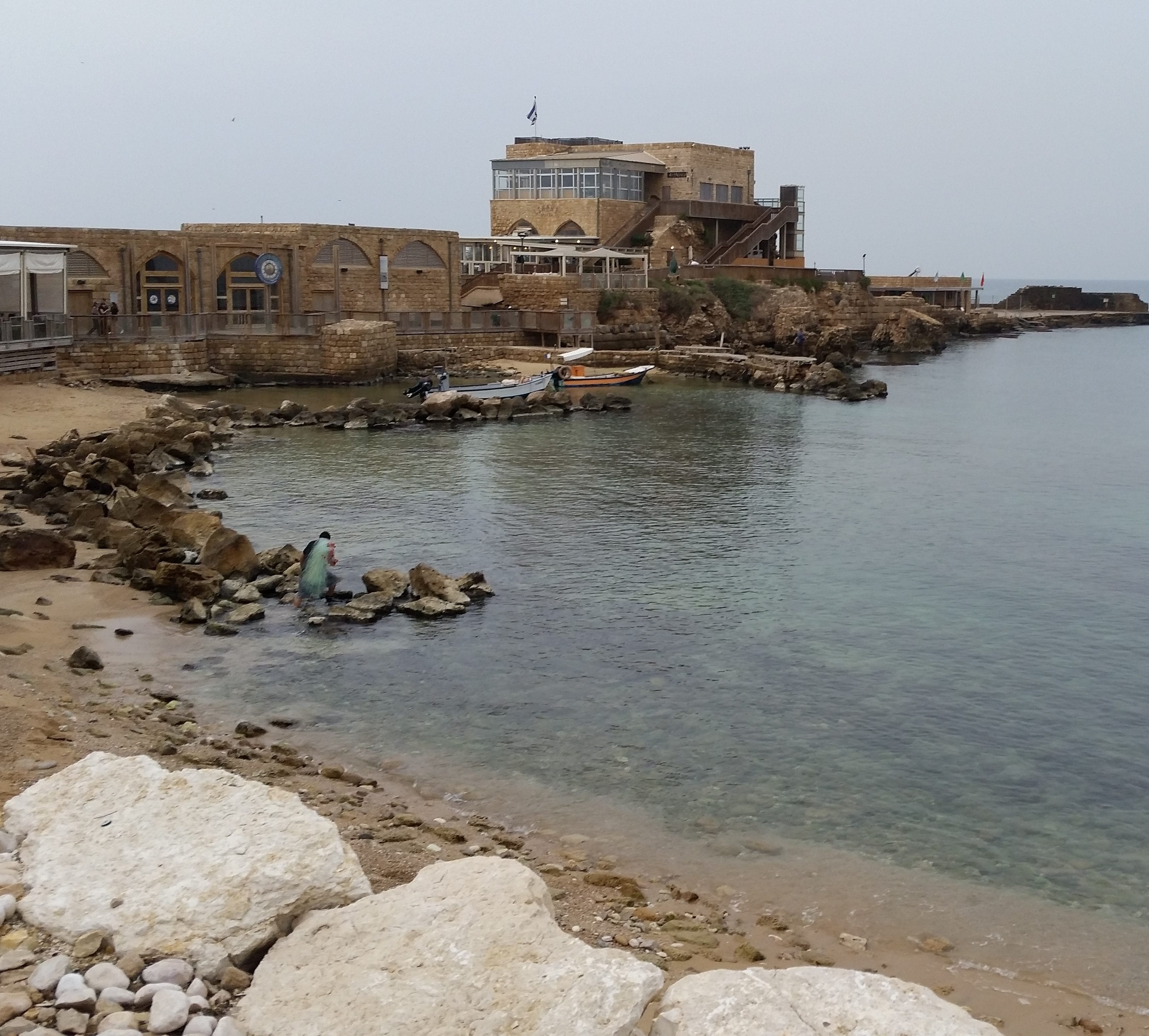
Caesarea Maritima on the Mediterranean
Caesarea Maritima was the largest of Herod the Great’s construction projects. While the Temple Mount in Jerusalem had been designed to impress Herod’s Jewish subjects with his devotion to God, and Masada had been designed to keep Herod safe and comfortable in case the Jews weren’t entirely convinced, Caesarea was designed to impress Rome with Herod’s loyalty to the emperor–and with his ability to execute such an extensive project.
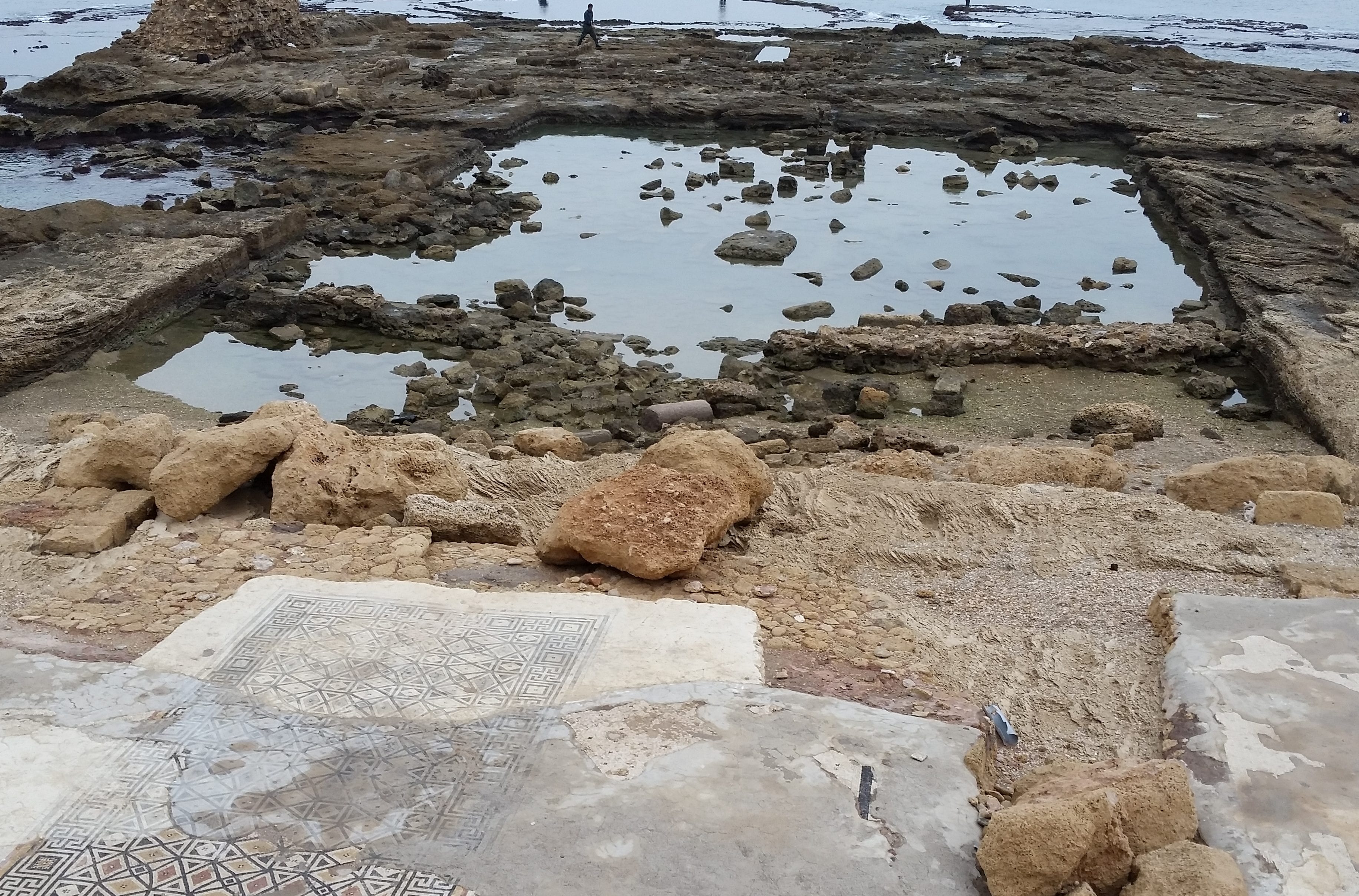
What remains of one of Herod’s swimming pools
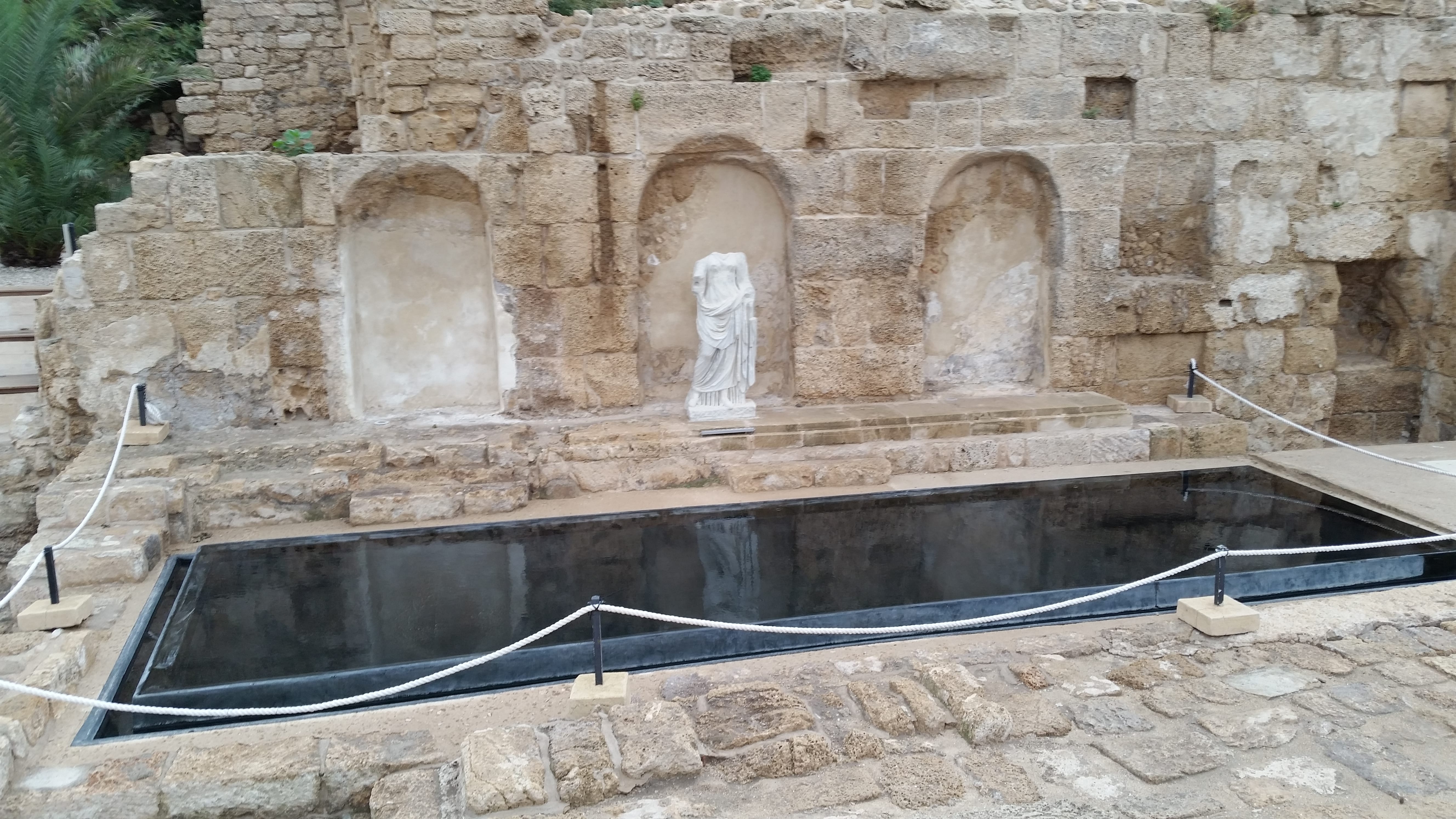
Reconstruction of a reflecting pool
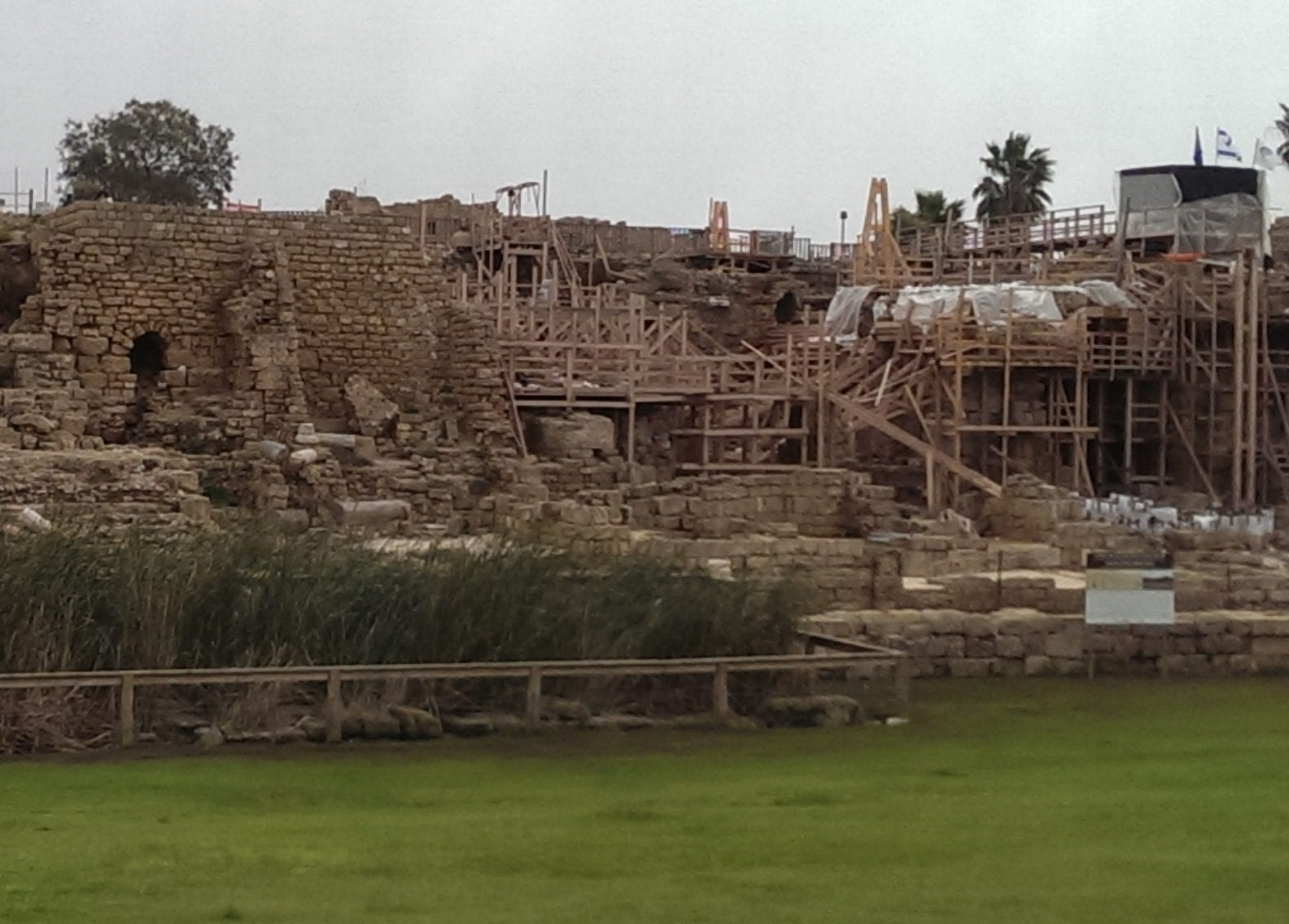
Reconstruction of the Temple Vaults at Caesarea Maritima
Starting at the site of a small Phoenician port, Herod created a huge artificial harbor in the Mediterranean and then set about turning the old village into a combination workplace-playground for his influential cohort. During the years between 22-10 BC, Herod built warehouses and marketplaces, temples and synagogues, civic buildings and palatial residences, public bathhouses and private spas, all connected by wide, paved roads. Because there are no rivers or natural springs in the vicinity, he constructed an aqueduct all the way from the foothills of Mount Carmel to bring fresh water into Caesarea.
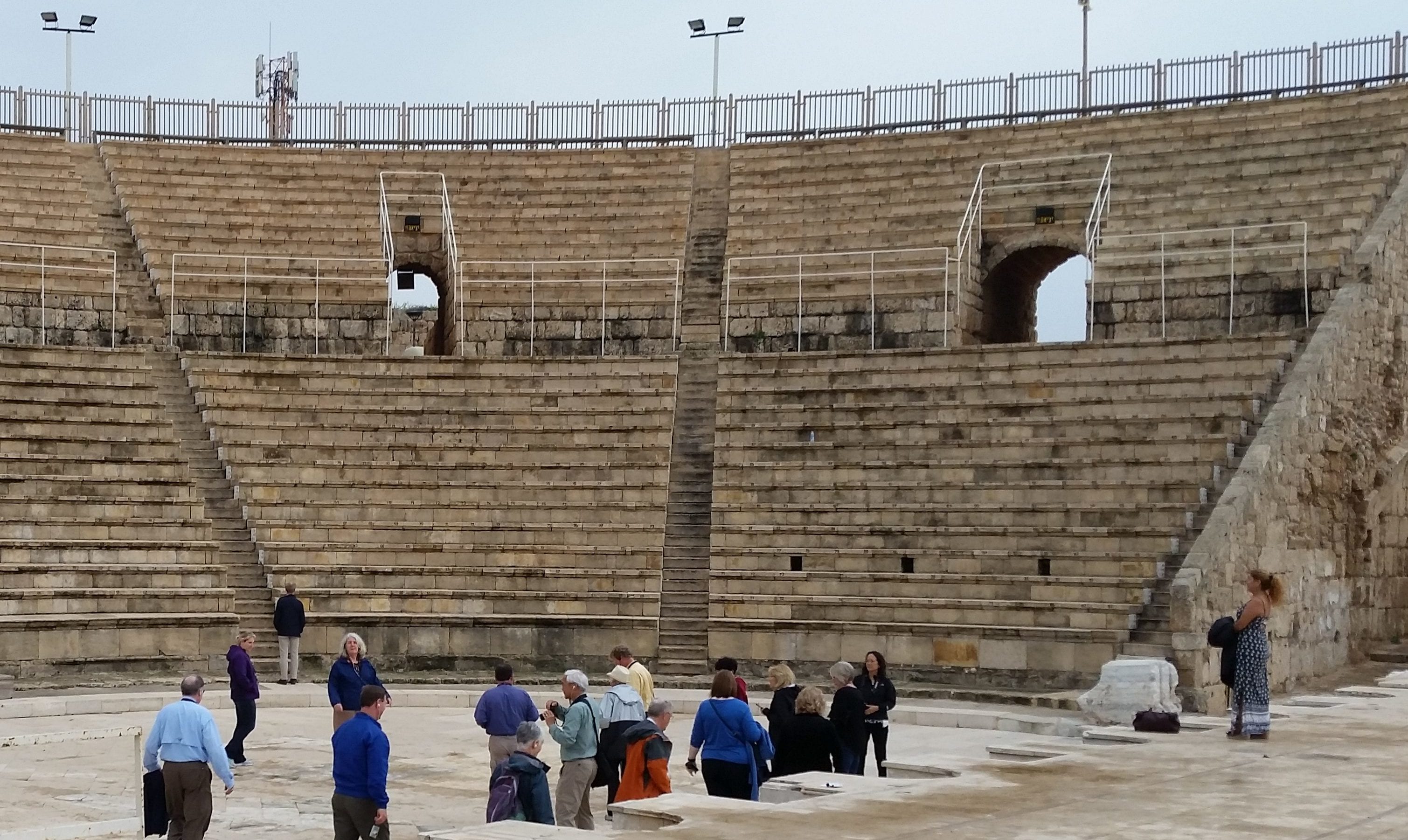
Roman theater

Hippodrome
To entertain the city’s growing population (estimated at 125,000), he built two theaters and a huge hippodrome for sports competitions, chariot races, and gladiator games. (Centuries ago, thousands of Christians died for the sake of spectator sport here. This afternoon, Scott treated us to a more uplifting form of entertainment, demonstrating the amphitheater’s amazing acoustics with a stirring rendition of “How Great Thou Art.”)
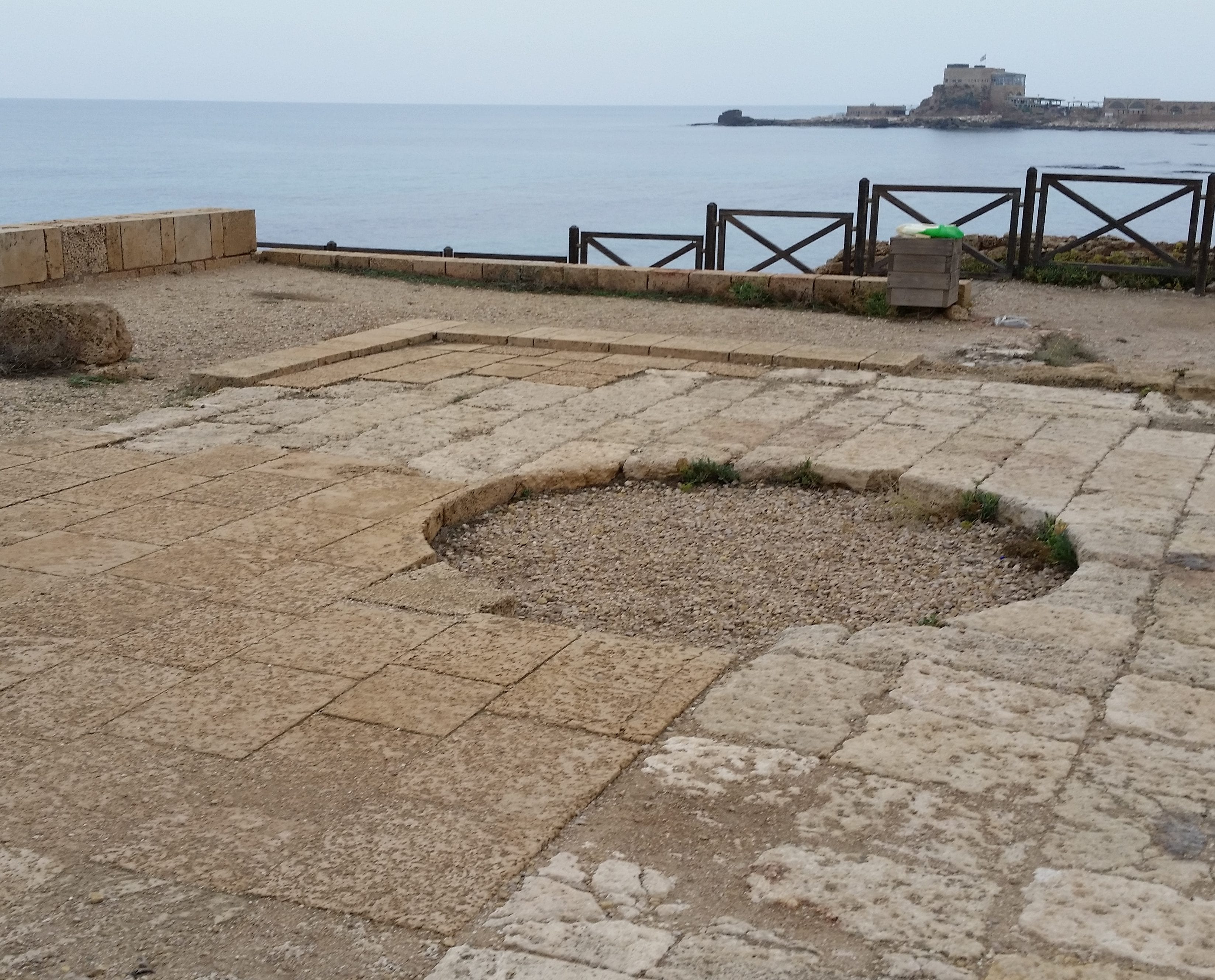
Porch where Paul likely testified to Agrippa
As the administrative center of Judaea Province of the Roman Empire, Caesarea was the home of Pontius Pilate, the procurator who reluctantly condemned Jesus to death. Other official residents of Caesaria mentioned in the scriptures include Felix and Festus, both of whom heard testimony from the apostle Paul before he was sent to be tried in Rome. Agrippa II, Herod’s great-grandson and heir to at least part of his kingdom, also heard Paul here in Caesarea. Agrippa was so moved by the apostle’s testimony of Jesus Christ that he commented, “Almost thou persuadest me to be a Christian.” (Alas, “almost” wasn’t enough.)
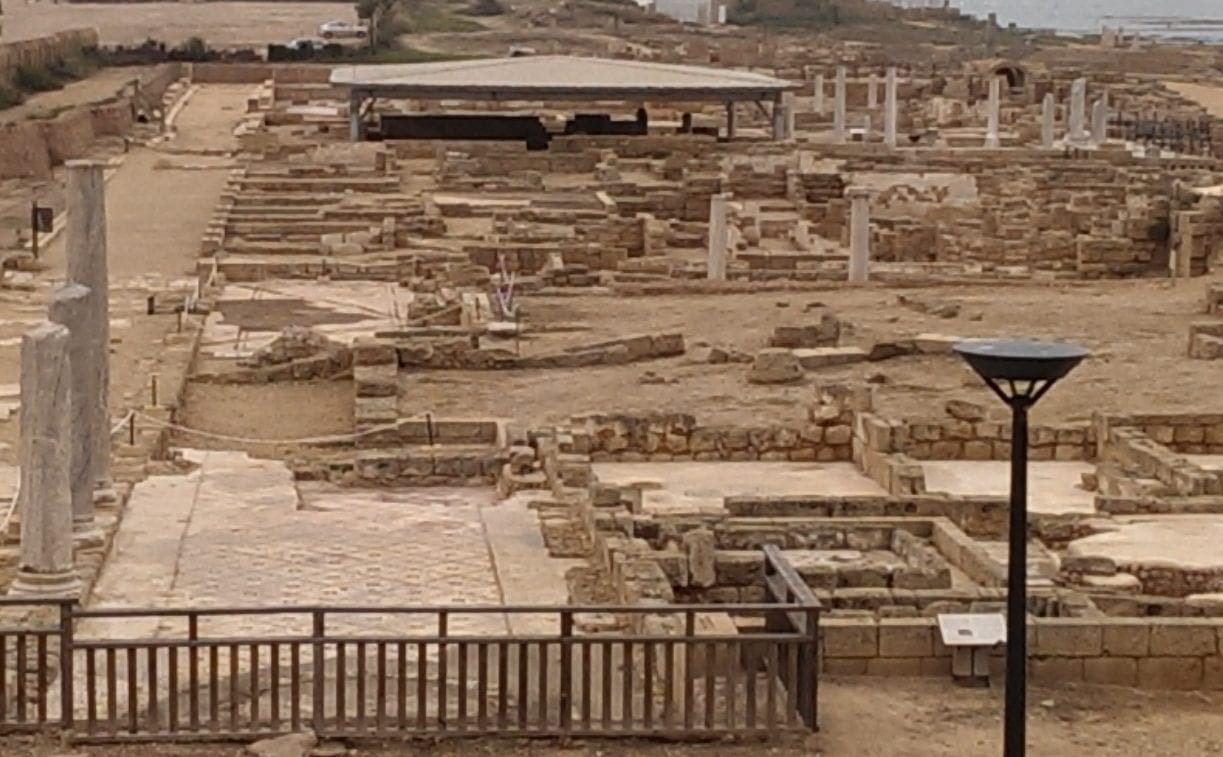
Excavation of Roman-era commercial buildings near the harbor
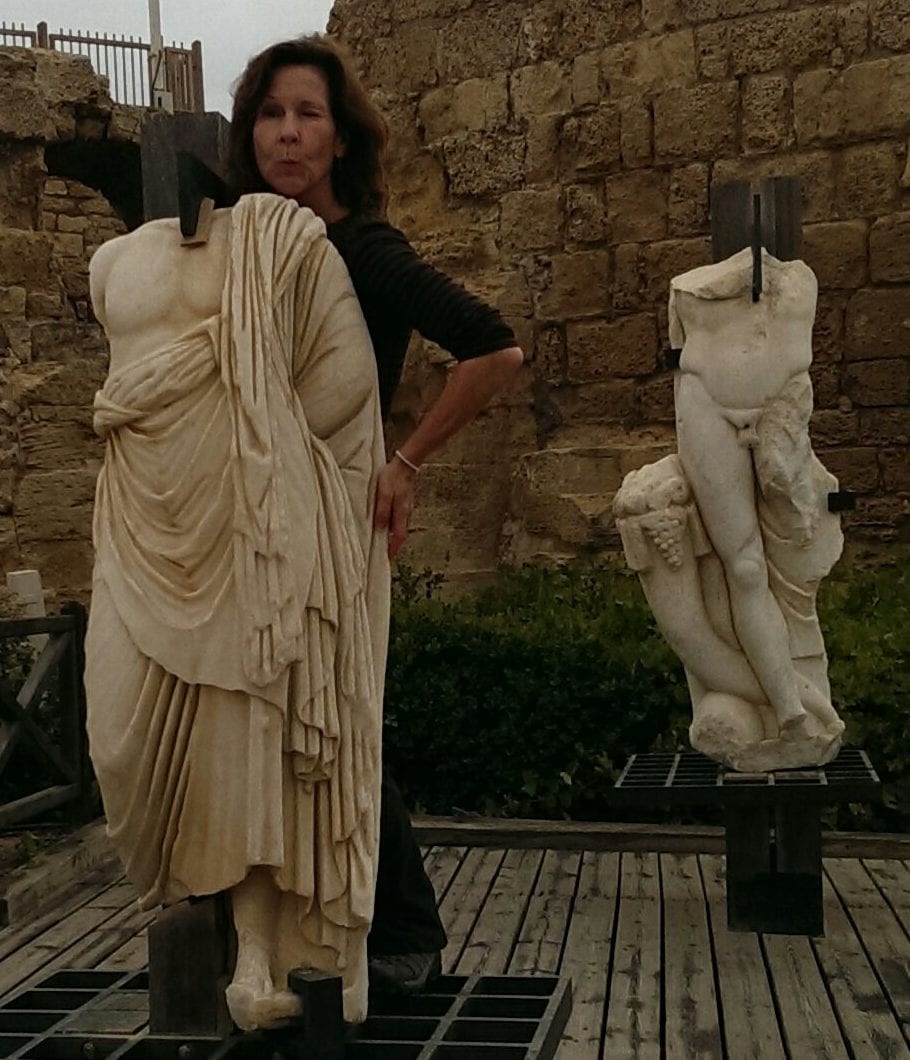
Judith adds her mug to a Roman statue
Caesarea Maritima was the venue for some other important New Testament events. Philip, one of the seven men chosen by the apostles to care for the temporal welfare of church members, established a household in Caesaria that became a haven for Paul and other Christian missionaries. Caesarea was also the home of Cornelius, the Roman centurion to whom Peter was sent following a dream in which God commanded him to eat “unclean” animals. Peter understood this as a sign that the gospel of Christ was not just for the Jews but for everyone, and thus Cornelius became the first Gentile to be baptized without first having converted to Judaism.
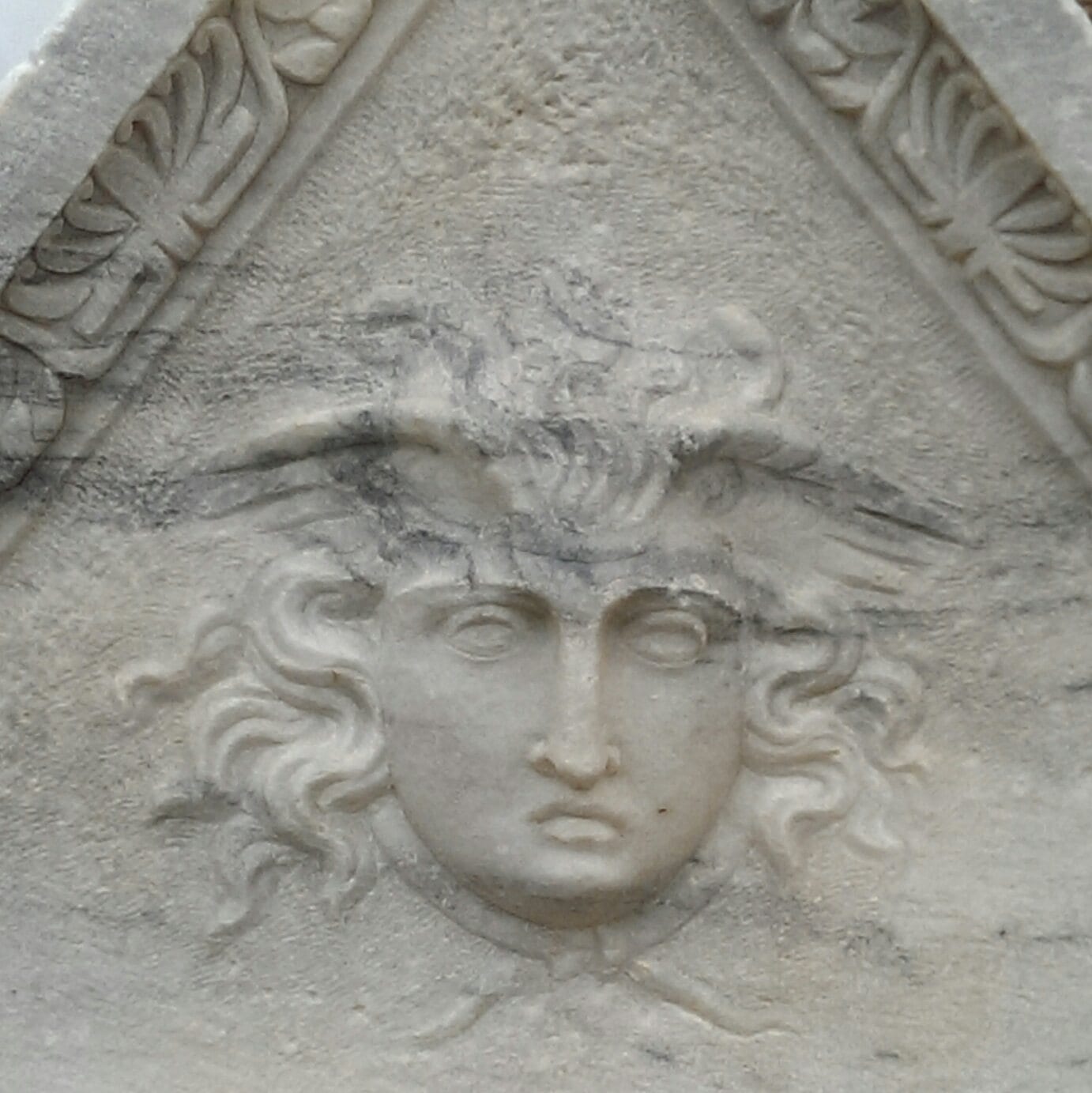
Medusa guards a portico
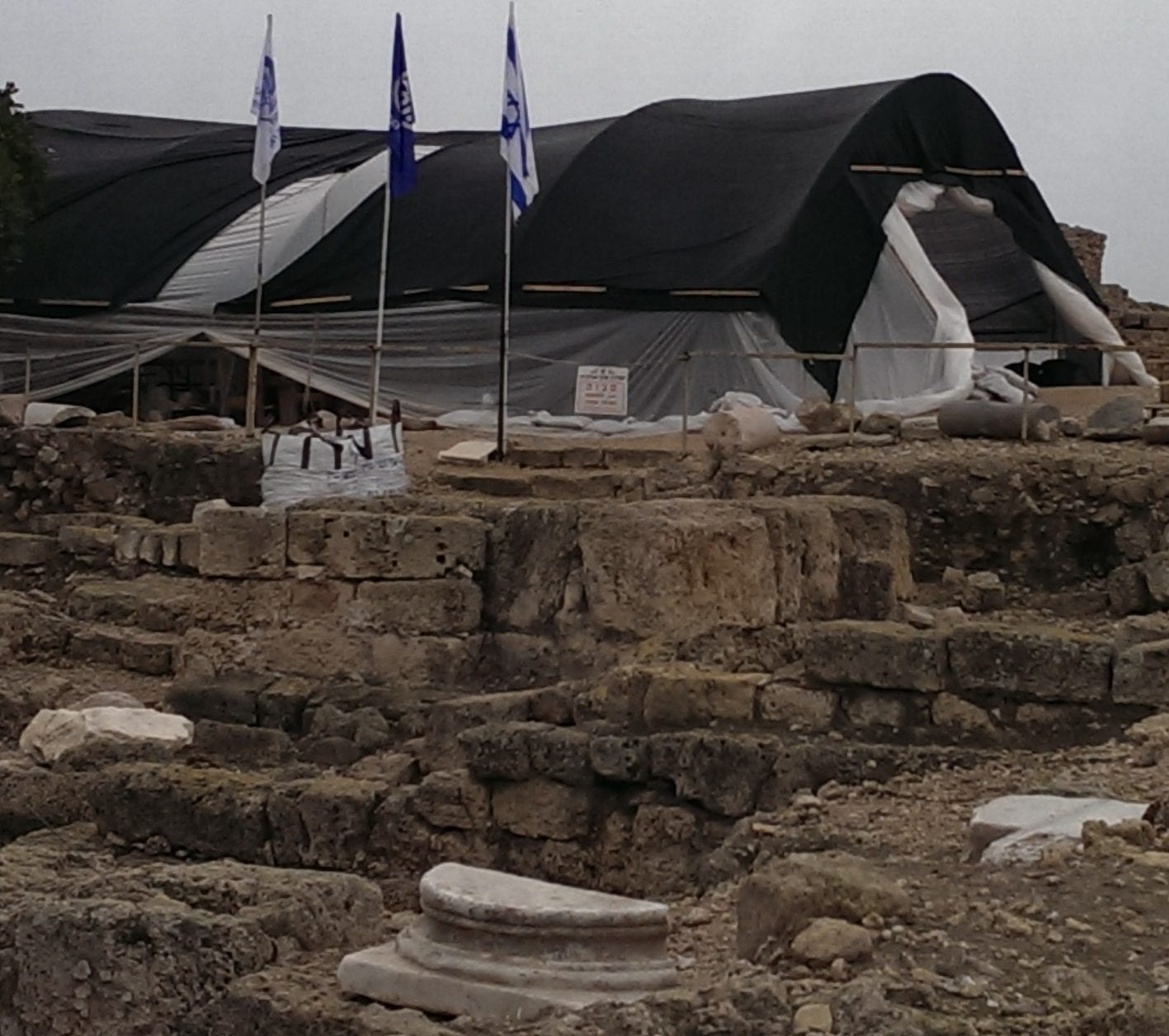
Excavation of the Crusader-era marketplace at Caesarea
The great harbor Herod built in Caesarea was irreparably damaged by the tsunami that swept through the Mediterranean following the eruption of Vesuvius in 79 AD. However, the city continued to thrive for centuries, changing hands many times along the way.
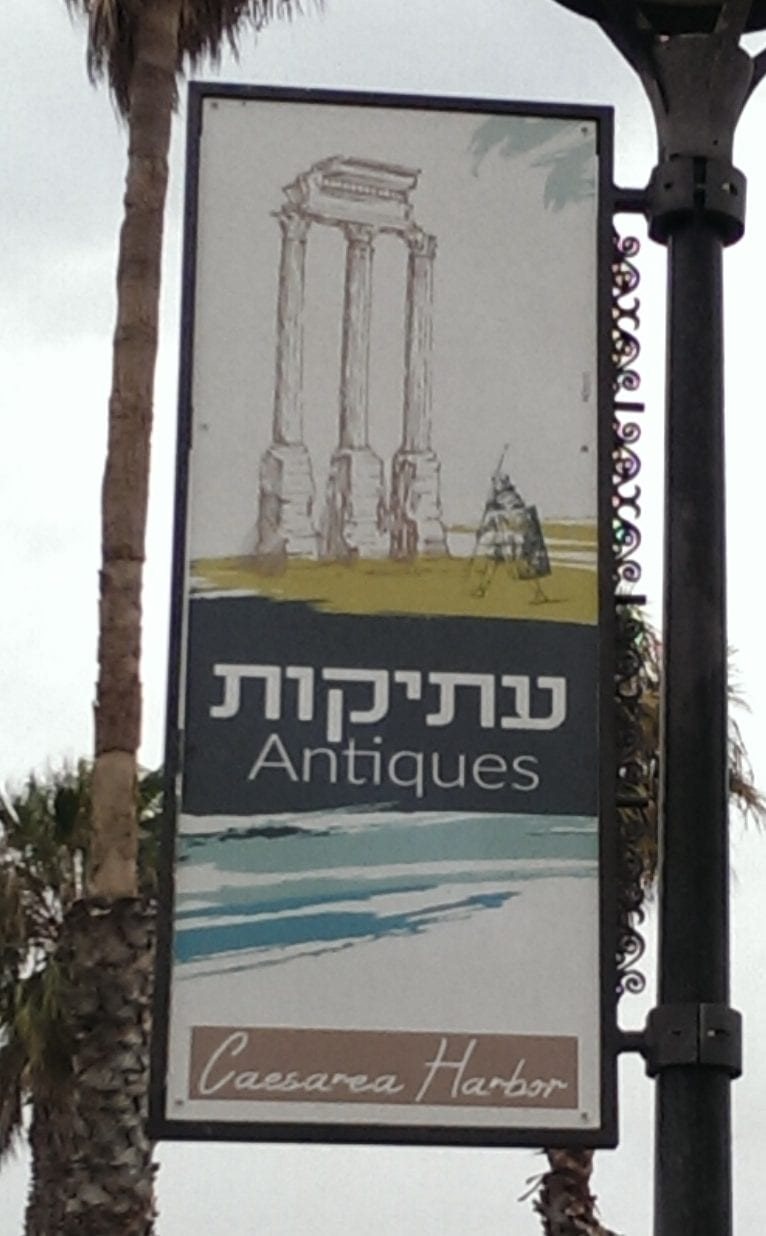
Signs touting Caesarea’s unique features from antiques to wakeboarding line the wide walkways
Today Caesarea has again become a commercial resort and entertainment center, managed by a private development corporation rather than the Israeli Nature and Parks Authority. In addition to extensive historical ruins, Caesarea Harbor also offers visitors a variety of restaurants, boutiques, art galleries, concerts, theatrical productions, boating, and water sports.
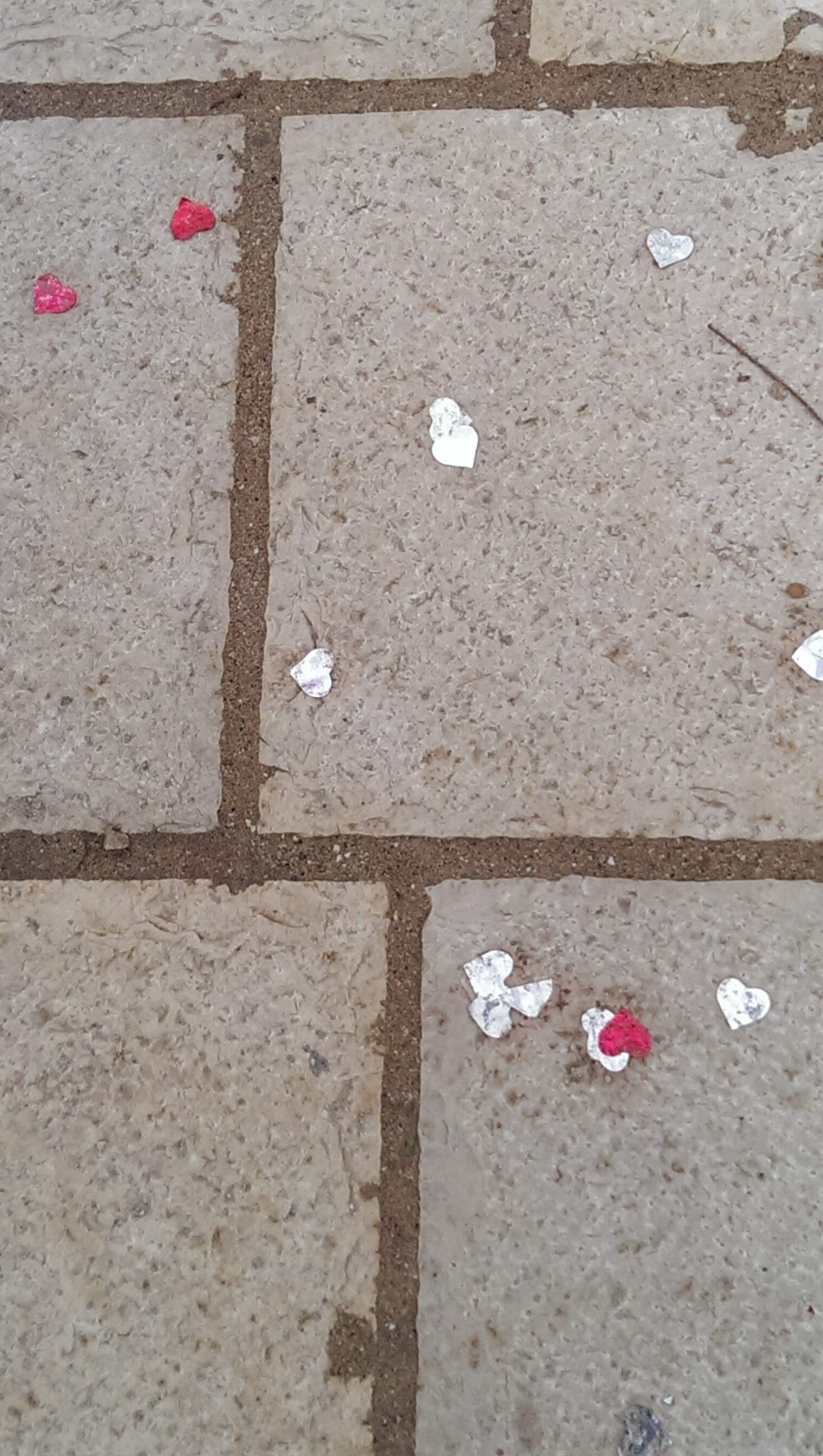
Confetti hearts litter the pavement after a wedding at Caesarea
It’s obviously a great place for a date night or weekend getaway, and apparently, it’s a popular venue for weddings and bar mitzvah celebrations, too. We enjoyed walking along the aqueduct and the adjacent beach, and watching seals play on the rocks offshore.
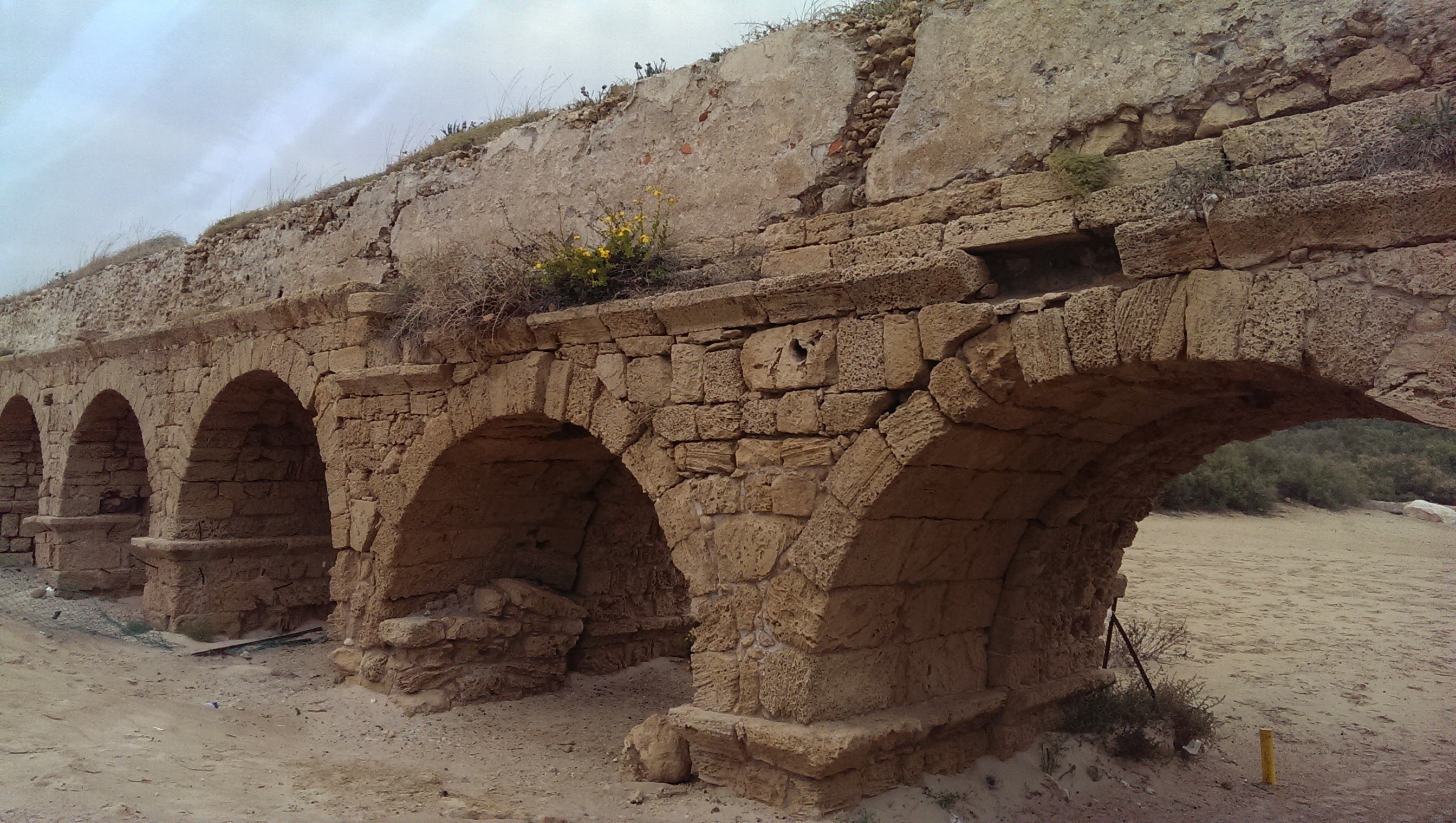
The aqueduct runs along the beach outside Caesarea
It was getting dark when we boarded the bus for the last time and headed south toward Ben Gurion Airport. The modern Israel we saw lit up as we drove along the coastal highway and through Tel Aviv looked much different from the ancient Israel we have been studying during the past two weeks, but no less enchanting.
We feel so blessed to have come on this trip, not just because of where we have been and what we have seen, but also because of those with whom we have shared the experience. We are so grateful that Judith and Richard, Lynn and Mark encouraged us to join them. We are so happy that Pat and Emery enthusiastically accepted our invitation to come along. And we are thrilled that several people who were complete strangers to us two weeks ago now have become dear friends. It was very hard to say goodbye to Ann, Mark, Marguerite, and Rusty when the bus let them off at the hotel in Jaffa where they will spend the night; their flights home don’t leave until tomorrow morning.
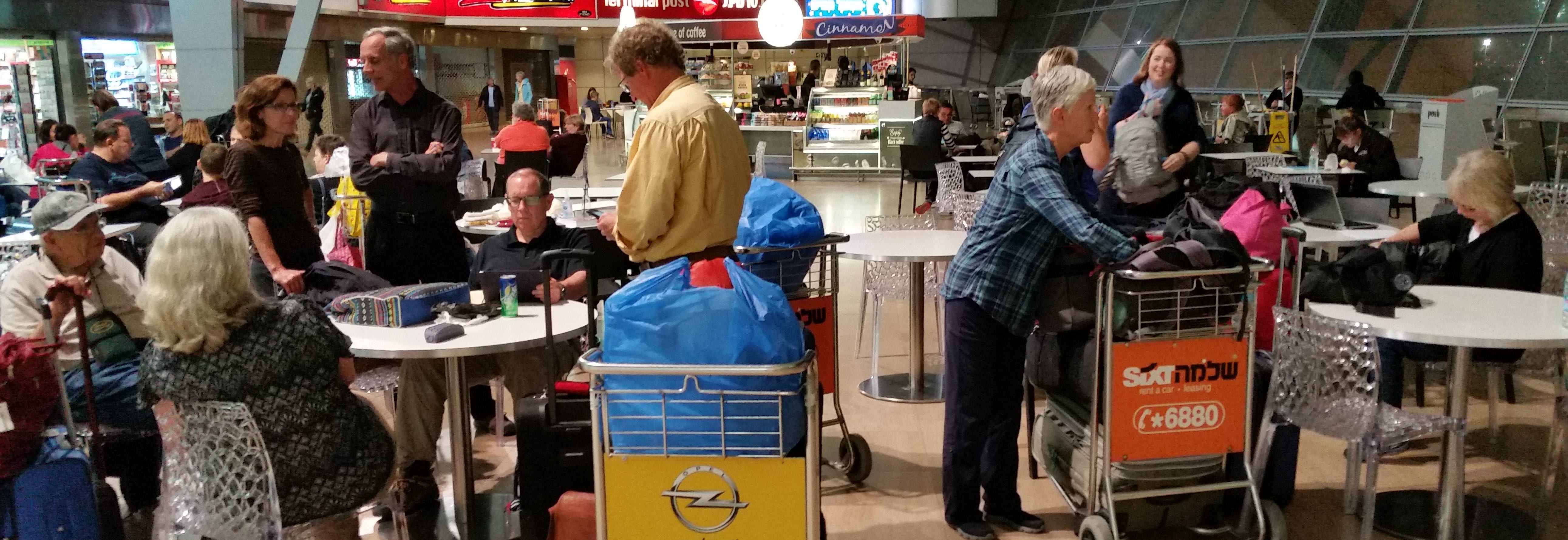
Awaiting our flights in Tel Aviv
Other friends began splitting off when we got to the airport and had to go through security. Many of us, however, are remaining together as we wait for our late-night flights.
Leave A Comment